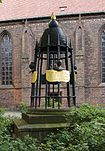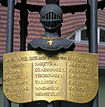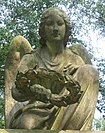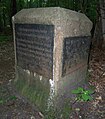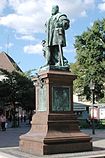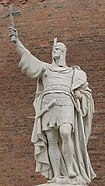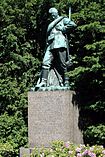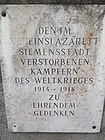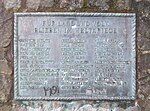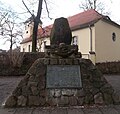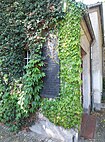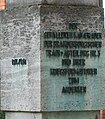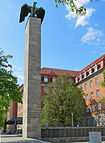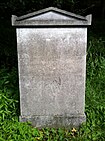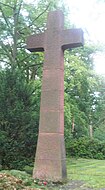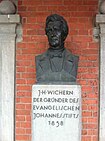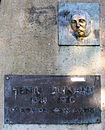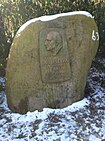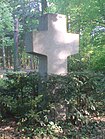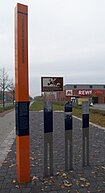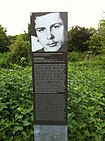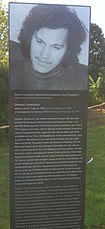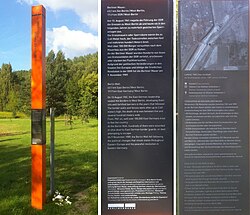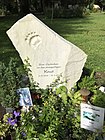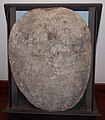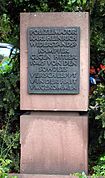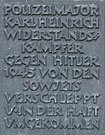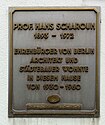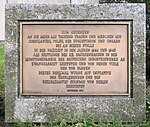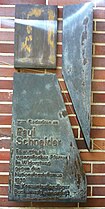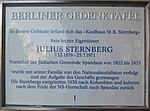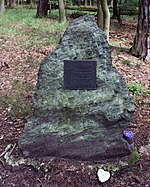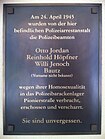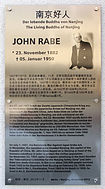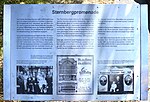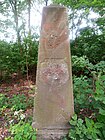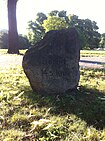Monuments in Spandau
The monuments in Spandau were created relatively late in what is now Berlin's district , as the city on the Havel as an agricultural town had little tax revenue. Although the number of residents increased as a result of the expansion of the armaments factories, the income remained low, as the army workshops did not have to pay any trade tax. The oldest monuments in Spandau are clearly oriented towards the function of the city as a garrison town ( war memorials ). It was not until later that personal monuments of the Elector, Emperor and Imperial Chancellor were added.
Definitions
Monuments are artistically designed monuments or structures (statues, statues, sculptures, steles , wayside shrines , memorial stones, stumbling blocks ) that were created with the aim of commemorating a historical event or anniversary, a custom or individual or several historical personalities to remember in public. As a rule, they have inscriptions or tablets.
The monuments in this list do not include cemetery grave monuments for individual persons, architectural or ground monuments according to the Berlin Monument Protection Act or natural monuments according to the Berlin Nature Protection Act . Artistic sculptures in public spaces that were not erected to commemorate (“ art in architecture ”) are also not considered to be monuments . These sculptures are described under Sculptures in Spandau .
A memorial plaque is understood here to mean inscriptions, written tablets or picture panels that are also intended to publicly remind of a historical event or anniversary, a custom or individual or several historical personalities without being erected in connection with a monument. These can also be individual tablets that are attached to a simple stone that is not particularly artistically designed.
The memorial plaques do not include inscriptions or tablets that are merely explanatory (e.g. about the construction history of a building).
In the headings of the individual monuments and memorial plaques, the respective year of construction - if known - is given in brackets.
Cultural monuments (or architectural, garden and ground monuments), within the meaning of the Berlin Monument Protection Act, are in the lists of cultural monuments for the individual districts of the district: Spandau , Haselhorst , Siemensstadt , Staaken , Gatow , Kladow , Hakenfelde , Falkenhagener Feld and Wilhelmstadt .
Monuments
The following monuments are currently preserved:
Spandau lock memorial stone (1815 [?] / 2002)
|
With the new construction of the Spandau lock , an old memorial stone within the lock area, which reminds of the history of the lock system in Spandau, was restored. The sandstone memorial to the east of the lock chamber is not open to the public, but can be seen from the lock chamber or from the green area at the citadel moat. Inscription (text in capital letters): Unter / Friedrich Wilhelm III. / started in 1812 / stopped during the siege in 1813 / ended in 1814 and 1815 |
- Location: Möllentordamm 5A ( old town ) 52 ° 32 ′ 24.4 ″ N , 13 ° 12 ′ 34.4 ″ E
Fallen of the Wars of Liberation 1813–1815 (1816)
|
The monument designed by Karl Friedrich Schinkel in the style of eclecticism was inaugurated on April 27, 1816; A pewter capsule has been walled into the foundation stone. The monument commemorates the wars of liberation from 1813–1815 against France, led by Napoleon . The sculpture on today's Reformationsplatz (former churchyard and then Heinrichplatz) at St. Nikolai Church was originally surrounded by three oaks that were planted in autumn 1815 (two of which are still standing today), which were planted to commemorate the end of the wars of freedom had been. Originally, an iron grating with four openings surrounded the square; this was removed in 1933 because it was dilapidated. In 1995 the monument was restored and in 1996 the associated green area was redesigned. The memorial consists of twelve interconnected iron lances with flaming bombs. Four coats of arms adorned with knight helmets and bearing inscriptions are attached to the lances, which are provided with an iron roof. Inscription (northwest side, text in capital letters ): Who calls this ore to you, wanderer, / in victory for our freedom they are lucky / they have fallen, / the thanks let their heroic names / not fade away / that they are still emulating their late / grandson knows. |
- Location: Reformationsplatz ( old town ). 52 ° 32 '19 " N , 13 ° 12' 18.9" E
French war memorial (after 1871)
|
The memorial, also known as the “French Cross”, commemorates the 400 French prisoners of war from the Franco-German War of 1870/1871 who died of smallpox in Spandau . The sand-lime brick memorial was erected by fellow prisoners. In 1932 it was restored and moved from the original location, the cemetery of the garrison / St. Johannis community (today: Koeltzepark) on Neuendorfer Strasse, to the cemetery “In den Kisseln” (Section 48a). Inscription : Souvenir Eternel / a nos / Frères d'armes / 1870–1871 (badly weathered, hardly legible). The crossbars of the cross bear the gilded inscriptions on both sides: Erigé par leurs compatriots and In cruce salus |
- Location: Pionierstraße 82, “ In den Kisseln ” cemetery ( Falkenhagener Feld ). 52 ° 33 '28.6 " N , 13 ° 10' 27.7" E
Memorial to those who fell in the Wars of Unification in 1864, 1866 and 1870/1871 (1875)
|
The free-standing memorial (memorial body made of granite over a floor slab, angel originally in zinc , replaced by concrete in 1983) was created in 1875 by Ernst Herter . It was donated by the lime distillery owner Ernst Friedrich Schulze for the fallen soldiers of 1864, 1866 and 1870/1871. a. also for his son who had died in France . The monument, which was badly damaged in 1923, was restored in 1932 by the Spandau District Office. Like the French war memorial, it was then moved from the cemetery on Neuendorfer Strasse to the “ In den Kisseln ” cemetery (Section 48a). Because of the figure on the base, the monument is also named after the goddess of victory Nike . |
|
Inscription (front, text in capital letters ): To the men of the good sons of Spandau who fell for the / fatherland / for constant memory / dedicated / in grateful recognition The names of 27 dead are mentioned on the name plate. Inscription (back): Be faithful to death, so I / you will give the crown of life. / Rev. Joh. 2.10. |
- Location: Pionierstraße 82, “ In den Kisseln ” cemetery ( Falkenhagener Feld ). 52 ° 33 '28.9 " N , 13 ° 10' 26.6" E
Memorial stone Crown Prince and Prince Heinrich Beech (1881/1966)
|
Where the course of the Kuhlake almost ends in the north of the Spandau Forest, around 400 meters before reaching the Eiskeller -Wiesen a memorial stone commemorates the (no longer existing) Crown Prince Beech and Crown Prince Friedrich Wilhelm, who later became Emperor Friedrich III. who leased the hunt in the 1860s and took an active part in extinguishing a forest fire on April 16, 1881 with his son Prince Heinrich . A postcard from around 1910 shows the then splendid tree. Inscription (obverse): Woodcock looked for in the area / The Crown Prince and Prince Heinrich here. / There hurt! The fire rages not far in the forest. / Hey! Both gave a helpful hand! / I saw it and am now a happy piece of wood, / My name is and the whole forest is proud: / Crown Prince and Prince Heinrichs / Beech. |
| Inscription (reverse): Dedicated in gratitude. / Spandau, April 16, 1881. / The magistrate. The Forest Deputation. / Ganzler, city forester. |
|
According to the inscription on a plaque added in 1966, the memorial stone was damaged in the Second World War and placed again in the Spandau Forest in 1966. Inscription of the added third plaque on the right (text in capital letters ): The memorial plaque was damaged / 1945 during the fighting / around Berlin / Renewed at the suggestion of / Forester Beyer / 1966 / District Office Spandau . Apparently, another beech was identified as the Crown Prince's beech in 1966, because in 2009 the stone was found whose historical position, according to a historical survey plan proven by the district's land surveying office, is located at 52 ° 35 ′ 25.7 ″ N , 13 ° 9 ′ 20, 1 ″ O , 35.20 meters from the original location before (measurement from October 22, 2009). In mid-2009, only about three to four meter high remains of dead wood were left of this tree , in October 2009 the tree stump was found fallen over. The place is in a relatively poor condition and is not easy to find (30 meters west of the Kuhlake in the forest). Two weathered benches invite you to rest. The Spandau forestry office, together with the district's land surveying office and the monument protection training course at the upper level center for building technology I in Spandau, intends to reconstruct the historical situation (circular paths) and to replant a solitary beech at the original location. |
- Location: Spandauer Forst, Jagen 69 ( Hakenfelde ) - the memorial stone. 52 ° 35 ′ 26.8 ″ N , 13 ° 9 ′ 20.2 ″ E is no longer in the original position.
Monument to Elector Joachim II (1889)
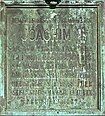
|

|

|

|
| On November 1, 1539, the Reformation was introduced in the Mark Brandenburg . On this day, Elector Joachim II received the Lord's Supper in the St. Nikolai Church from the Brandenburg bishop Matthias von Jagow in both forms , that is, with bread and wine, with which he announced the conversion to the Lutheran creed. On the occasion of the 350th anniversary, the monument to Elector Joachim II was erected in front of the church portal of St. Nikolai Church in 1889. The three-meter-high statue ( bronze ) on a four-meter-high pedestal of polished Swedish granite was made by the sculptor Professor Erdmann Encke created and in the Lauchhammer art and bell foundry cast. It was also called the Reformation Monument. Inscription (dedication plaque on the front of the base, text in capital letters ): Dem Kurfürsten v. Brandenburg / Joachim II. / On the 350th anniversary of / on November 1, 1539 in the / St. Nicolaikirche zu Span- / last ceremony / conversion of this Fuers / ten to the evangelical faith / erected in 1889.
Next to it there are three bronze relief pictures with pictures of the elector. |
- Location: Reformationsplatz ( old town ). 52 ° 32 '17.8 " N , 13 ° 12' 17.3" E
Monument to Albrecht the Bear (1898)
|
This monument shows Albrecht the Bear (approx. 1100–1170), the founder of the Mark Brandenburg . The approx. 2.5 meter high sculpture stands in the courtyard of the Spandau Citadel on an approx. 1.5 meter high base. Inscription (base front, text in capital letters ): Albrecht / Der / Baer / 1100–1170 The monument was originally a monument group, together with busts of Bishop Wigger of Brandenburg and Bishop Otto von Bamberg , part of the world-famous Monument Street, which Kaiser Wilhelm II had laid out from 1898 to 1901 in the former Siegesallee in the Tiergarten . It led from Kemperplatz on the southern edge of the Tiergarten to the Victory Column, which at that time stood on Königsplatz near the Reichstag building . Margrave Albrecht was the main figure of the first of 32 monument groups of the rulers of Brandenburg and Prussia, with which the history of Brandenburg and Berlin was to be remembered. In the Berlin vernacular the venerable statues were called "dolls". The popular saying "... stay up until the dolls ..." referred to this and meant having to stay up late, because an evening rendezvous on Siegesallee could take a long time due to the distance to the then city center. As early as 1938, the figures were removed from their original place because they stood in the way of Albert Speer during his gigantic transformation of Berlin into the “ world capital Germania ”. The second location, the large Sternallee, was also removed after the monuments were dismantled in 1950. It was not until the 1980s that the monument to Albrecht the Bear reached the citadel. The monument group was erected by Walter Schott , and the unveiling took place on May 6, 1898. The bishops belonging to this monument group have been stored in the Spandau Citadel since May 2009 . |
- Location: Am Juliusturm 64 ( Spandau Citadel , Haselhorst ). 52 ° 32 '25.2 " N , 13 ° 12' 45.9" E
Memorial stone of the howitzer battery Baumgarten (1906)
The memorial stone was set as a landmark in 1906 with funds from the city of Spandau (180 marks ) to commemorate the historic Baumgarten howitzer battery, which on the first Easter holiday in 1813 under the leadership of Lieutenant Baumgarten , fired four howitzers at the French troops in the Spandau Citadel , where the Juliusturm was set on fire and hundreds of quintals of powder were exploded in the bastion "Queen". The monument consisted of a 75 cm high square granite block with a side length of 40 cm and a tent-like top.
It bears the inscription : The howitzer battery / Baumgarten / in memory, / which from this point / on April 18, 1813 / set fire to the Citadelle / and brought about the liberation / Spandau / from the French yoke /. (See illustration)
The memorial stone, which was newly fenced in in August 1924 and planted with four trees, was placed in the historically incorrect location at the transition to the south curtain of the citadel in 1977 (not accessible in June 2010). According to tradition, the actual location of the Baumgarten battery was between Ruhleben and Spandauer Berg ( Charlottenburg ), around one kilometer east of the location of the memorial stone. Measurements based on old maps and reports had shown the location of the memorial stone selected in 1906 as the center of the extensive battery positions.
- Location: historical: north of the Charlottenburger Chaussee (it should have been clearly visible from the street), on the grounds of Deutsche Werke AG , Maschinenfabrik-Süd (probably near today's Bauhaus site, Spandau ). 52 ° 31 '42.1 " N , 13 ° 13' 8.9" E
- Location: today: Am Juliusturm 64, ( Spandau Citadel , Haselhorst ). 52 ° 32 '25.5 " N , 13 ° 12' 50.8" E
Pioneer Monument (Monument Pioneer Carl Klinke) (1908)
|
The worker and soldier Carl Klinke , who was born on June 18, 1840 in Bohsdorf (Lausitz), died on April 18, 1864 during the storming of the Düppeler Schanzen near Sonderburg in the Prussian-Danish War . In Prussia , Klinke was revered for his self-sacrificing heroic death; he blew himself up with a sack of powder in the hill and thus enabled the troops of the German Confederation to take the fortification . The monument, unveiled on May 31, 1908, is located in a green area on Klinkeplatz of the same name (until 1937 Düppelplatz ). The design of the 2.3 meter high bronze sculpture on a two meter high base made of polished Bavarian granite comes from Professor Wilhelm Wandschneider and was cast near Gladenbeck in Friedrichshagen. The Danish flag , the Danebrog , lies broken at the feet of the pioneer, who is equipped for the storm - between the blown bulwarks . Inscription (obverse, text in capital letters ): Our comrades who fell and died in the campaigns of 1864, 1866 and 1870/71 for king and fatherland as well as in China and South West Africa for the emperor and empire, especially the pioneer Karl Klinke of the 4th Company, who in the storm on the Düppeler Schanzen on April 18, 1864 his self-sacrificing heroic death found in memory. Loyal to the battalion on April 18, 1909, appropriated by the Association of Comrades from the Pioneer Battalion von Rauch (Brdbg.) No3 in Berlin Inscription (back, text in capital letters ): Faithfulness adorns itself with deeds, not with words. |
The inscription, which has become almost illegible over the decades, was restored by Spandau master stonemason Bernd Kuhne in August 2010. The restoration work was financially supported by the Schützengilde zu Spandau .
- Location: East of Schönwalder Allee at Klinkeplatz, in a small green area ( Hakenfelde ). 52 ° 33 '21.7 " N , 13 ° 11' 56.1" E
World War I Memorial Hospital Victims 1914–1918 "In den Kisseln" (1918)
|
The monument to the victims of the First World War who died in the Siemensstadt hospital is located in the northwest area of the Spandau cemetery “ In den Kisseln ” in the Ehrenfeld . The memorial donated by the Siemens company was originally located in the Haselhorst cemetery on Nonnendammallee, which is now abandoned. In 1961, the war victims were transferred to Dept. 51 at the In den Kisseln cemetery . In 1985 it was restored with a donation from Siemens. Inscription (text in capital letters ): To / honorary / commemorate / honorary / commemorate / die in / club hospital / Siemensstadt / deceased / fighters / of / world war / 1914-1918 |
- Location: Pionierstraße 82, “In den Kisseln” cemetery ( Falkenhagener Feld ). 52 ° 33 '32.9 " N , 13 ° 10' 29.8" E
Memorial for the fallen from 1914–1918 "In the Kisseln" (1918)
|
On the Spandau cemetery "In den Kisseln" is the cemetery of honor, laid out in 1919 for the sons of Spandau who died in World War I. The monument, which is also known as the “ Stahlhelm ”, is part of a larger memorial with an urn field (grave field 37). The design of the cemetery of honor comes from city building officer Karl Elkart and the architect Heinrich Wolff . The sculpting work was done by Richard Kuhnert . The stele made of shell limestone wears a steel helmet with an oak wreath and is surrounded by a railing with shell limestone balls and forged chains. Inscription (text in capital letters ): Your sons who died in World War 1914–1918, The City of Spandau |
- Location: Pionierstraße 82, “In den Kisseln” cemetery ( Falkenhagener Feld ). 52 ° 33 '21.2 " N , 13 ° 10' 26.3" E
Flora monument (1919)
|
The socio-political monument commemorates the housing shortage after the First World War and the efforts of the city to remedy it. The monument was made from shell limestone by the sculptor Georges Morin . The sculpture shows the ancient Roman goddess of flowers kneeling on a square base; she holds up a cornucopia and empties it. Inscription (front) (2009: completely weathered, illegible) : After the great / war, this / assembly was built by / the city of Spandau / to alleviate the / housing shortage in / 1919. The vernacular is said to have given this sculpture the name " Rosa Luxemburg " in the 1920s . |
- Location: On the square in front of the houses at Betckestrasse 27/28 ( Wilhelmstadt ). 52 ° 31 '16.7 " N , 13 ° 11' 57.1" E
Else monument
|
The sandstone cuboid on two podium steps, a design by the sculptor August Gaul , has inscriptions on three sides that are reminiscent of an Else. Which person is involved cannot be determined on site. It is about Johannes Guthmann's sister, Else Guthmann, married. von Morgen (1870–1910). Joachim Guthmann describes the installation of the memorial stone in his memoirs. Inscription (1st page, text in capital letters ): Else / my dear sister / in memory Inscription (2nd page, text in capital letters after Johann Wolfgang von Goethe ): You are not a dream image, as / I see you, / You were, you are. The deity / once thought and / represented you / perfectly. / So you partake of the / infinite / the eternal and are / forever mine. Inscription (3rd page, text in capital letters after Johann Wolfgang von Goethe): Stay with me, you beloved / picture, / completely forever young and / forever the same! / Let your clear eyes / pure light / shine around me all the time! / Hover before / where I am walking, show me / the way / through this earth thorny / labyrinth! |
- Location: Neukladower Allee 12, in Gutspark Neukladow ( Kladow ). 52 ° 27 '31.6 " N , 13 ° 9' 38.4" E
Monument to the Guard Grenadier Regiment No. 5 (1922)
|
The memorial was unveiled on May 21, 1922. Members of the regiment had already promised each other when they were mobilized in 1914 that the survivors would erect an appropriate memorial to the fallen of the First World War ; a basis for this was already collected during the war. The bronze sculpture with the name Die Wacht , a warrior with a short sword - clad only in a steel helmet and a loincloth - and an eagle at the warrior's feet, was made by August Schreitmüller ; he had originally created it as a war memorial for cemeteries. The sculpture is placed on a simple long plinth made of Franconian shell limestone , which in turn stands on a slab made of Silesian granite (made by the Berlin funeral monument society Schleicher). The memorial is dedicated to the more than 4,000 dead of the 5th Guards Grenadier Regiment. Inscription (obverse): His comrades who died in World War II / Das / Garde-Grenadier-Regiment Nr. 5 Inscription (back): 1914 [cross] 1918 The memorial had a simple predecessor on the former barracks area on the bank of the mill moat (see memorial column of the Guard Grenadier Regiment No. 5). |
- Location: In the green area Stabholzgarten ( old town ) 52 ° 32 ′ 3.1 ″ N , 13 ° 12 ′ 6.7 ″ E
Memorial of the Pioneer Battalion von Rauch (1922)
|
On a masonry substructure made of roughly hewn field stones (height 0.72 meters), a 1.25 meter high, light granite block (granite factory Wunsiedel in the Fichtelgebirge ) forms the monument, which was executed by the sculptor Wilhelm Wandschneider , who also created the Klinke monument . Oak leaves , a side gun and a steel helmet lie on an upper, smaller block . The inauguration of the monument, initially scheduled for April 18, 1922, and then June 25, 1922, was canceled or only carried out in silence because of the murder of Walther Rathenau the day before . The bronze plaque on the reverse was inaugurated on October 12, 1935 on the occasion of a pioneer meeting. Inscription on the base (front, text in capital letters ): 1914 Kreuz 1918 / Pionier-Bataillon / von Rauch / his fallen soldiers / in memory. Inscription on the bronze plaque (back, text in capital letters ): True to their / flag oath for king and / fatherland PBVRauch / 70 officers / 238 non-commissioned officers / 1564 private a. Pioneers. / Honor your memory |
- Location: in front of the property at Radelandstrasse 1, in the green area on the corner of Hohenzollernring ( Falkenhagener Feld ). 52 ° 33 '18.2 " N , 13 ° 11' 43.7" E
Memorial to the fallen soldiers of the 5th Guards Regiment on Foot (1923)
|
The memorial was inaugurated on May 6, 1923 and commemorates the more than 4,500 men and 160 officers of the 5th Guards Regiment who fell on foot in the First World War . The reverse shows a stylized iron cross and the year "1914–1918". The Berlin architect Heinrich Wolff created the design for the monument; The stonemason master Ehlert from Nauen took over the installation at the Askanierring . The monument, which was relocated on October 1, 1962 for traffic reasons, now consists only of parts of the base with pillar made of Brandenburg sandstone, which was originally much higher (4.8 meters high) and crowned with a soaring eagle (2.5 meters high) was. The eagle ( made from Cotta sandstone based on a design by the sculptor Professor Christian Behrens ), which was acquired by the Berlin Grave Monument Society Schleicher in 1922, was only removed after 1962. The remains of the eagle are in the Spandau Citadel in the exhibition in the Alte Kaserne. Inscription (front, text in capital letters ): Den im / World Wars / Fallen / Comrades. / [Guard star with the Latin words Suum Cuique (Each his own)] / d. 5th Guards / Regiments zF Inscription (back): [Cross] / 1914–1918 |
- Location: Originally on the median of the Askanierring (here today: Flankenschanze / Moritzstraße) at the corner of Moltkestraße (today Galenstraße), offset to the Hohenzollernring opposite house number 166 ( Spandau ). 52 ° 32 '25.9 " N , 13 ° 11' 43.5" E
Memorial to the fallen from Kladow (1924)
|
The monument made of field stones and inaugurated on August 31, 1924 is located behind the Kladow village church. Inscription (text in capital letters ): For country and people / stayed in the world war |
- Location: Alt-Kladow, across from house number 13 ( Kladow ). 52 ° 27 '10.3 " N , 13 ° 8' 43" E
Memorial to the fallen from Gatow (1925)
|
The monument, inaugurated on July 12, 1925, is located in the village cemetery in the Gatow district . It is a relief representation of two angels gathered around a grave site with a cross in a cartouche, which is embedded in the cemetery wall of the old village church on the Alt-Gatow street. Opposite, on the outside wall of the church, there is a plaque listing the names of 26 fallen. Inscription (above / below in the frame of the cartouche, text in capital letters ): History record the deeds of the heroes / and peace o adorn the fallen grave |
- Location: Alt-Gatow 32 ( Gatow ). 52 ° 29 ′ 11.7 " N , 13 ° 10 ′ 55" E
Memorial to the fallen from Staaken (approx. 1925)
|
The memorial erected for the fallen of the First World War is located in the rectory of the Staaken village church on the east side of the church. The year "1939–1945" was later added to the pedestal to simultaneously commemorate those who fell in World War II . Inscription on the cross (text in capital letters ): His fallen sons / Das dankbaren Staaken / 1914/1918 Addition on the base: 1939–1945 |
- Location: Hauptstrasse 12 / corner of Nennhauser Damm 72 ( Staaken ). 52 ° 31 '51.2 " N , 13 ° 8' 25.6" E
Memorial for the fallen soldiers of the Brandenburg Train Department No. 3 (1928)
|
The government and building council a. D. Erich Richter designed monument made of shell limestone was unveiled on May 13, 1928 and commemorates the dead of the Brandenburg Train Department No. 3 in World War I , whose barracks were located here. Inscription in metal letters (front, text in capital letters ): Den / fallen comrades / of the Brandenburg / Train Department No. 3 / and their / war formations / for / souvenir Inscription in metal letters (back): Symbol Krone / W / 1914 Inscription in metal letters (annex pages): 1914/1918 |
- Location: Wilhelmstrasse 26–30, in the front garden of the former train barracks ( Wilhelmstadt ). 52 ° 31 '9.5 " N , 13 ° 11' 3" E
Memorial to Friedrich Ludwig Jahn (1929)
|
Friedrich Ludwig Jahn (1778-1852) was the so-called "gymnastics father". The memorial was erected on June 6, 1929 by the Prussian University for Physical Education, the Prussian Ministry of Culture and the city. The male nude was designed by Ernst Wenck . The Jahn monument is a foundation by Ernst Wenck and is intended to symbolize the external and internal liberation of man. Inscription (text in capital letters ): A young man / a real German / young man I wanted to achieve / through German / gymnastics / Friedrich Ludwig Jahn |
- Location: Radelandstrasse 21 ( Falkenhagener Feld ). 52 ° 33 '21.1 " N , 13 ° 11' 32.1" E
Archer Monument - Spandau Rifle Guild (1934)
|
In 1934 the Schützengilde zu Spandau celebrated its 600th anniversary. To mark this occasion, on April 24, 1935, a memorial was erected in the middle of a roundabout of the driveway on the site of the traditional club, which was occupied in 1912, showing a shooter from medieval times when people were still shooting with a crossbow . The monument was created by the sculptor Emmerich Oehler . Inscription (front): 600 years / Schützengilde / zu Spandau. / 1334-1934. |
- Location: Niederneuendorfer Allee 12 ( Hakenfelde ). 52 ° 34 '4.8 " N , 13 ° 12" 42.9 " E
Memorial to the fallen of the Charlottenburg waterworks (1934)
|
Law was behind the main entrance of the waterworks on Rohrdamm / Motardstraße on 1 May 1934, a 1.5-meter-high boulder that tracks the the First World War fallen workers of "Charlottenburg Städt. Wasserwerke “is remembered, inaugurated. A steel helmet on a laurel branch is attached to the base in bas-relief . Today the stone stands in a green area near the main entrance to the Jungfernheide waterworks on Motardstrasse, which was closed in 2007. It is unclear whether this is the original location. Inscription (front): On May 1, 1934 / the employees who died in the World War / the Charlottenburg / Städt. Waterworks / in memory |
- Location: Motardstrasse 1–59 (odd house numbers), premises of the Berliner Wasserbetriebe ( Siemensstadt ). 52 ° 32 '0.5 " N , 13 ° 15' 41.2" E
Memorial stone Reichsforschungssiedlung (approx. 1934)
|
The memorial stone commemorates and heroizes the building of the Reichsforschungssiedlung Haselhorst . Inscription : The residential town of Spandau-Haselhorst was built in the years 1930–1934 by the non-profit housing / construction corporation Groß-Berlin on behalf of Reich and Prussia on historical fortification / ground of Spandau. It comprises 3000 small apartments that were created in 3 construction phases with the cooperation of many thousands of heads and hands. For around 13,000 people, this created / healthy living and housing conditions in a convenient location to their workplaces and at the same time / in nature and close to forest and water. (badly weathered, difficult to read) |
- Location: Lüdenscheider Weg / Haselhorster Damm " Reichsforschungssiedlung Haselhorst " ( Haselhorst ). 52 ° 32 '48.6 " N , 13 ° 14' 11.8" E
Memorial to the fallen of Siemens works (Siemens Memorial) (1934 and 1970)
|
The monument in the form of a sunken courtyard to commemorate the Siemens employees who died in the two world wars (Siemens Memorial) is located at the intersection of Rohrdamm and the corner of Nonnendammallee. A 24 x 28 meter square is laid out with granite slabs; This is limited by an approximately 1.80 meter high enclosure made of shell limestone with backing stones. The lower memorial square itself is accessible via six steps from Nonnendammallee. The first design ideas for a memorial already existed in 1921 with the aim of inauguration in 1922. However, the memorial was only designed years later after a competition by Hans Hertlein , the inauguration took place on August 5, 1934 by Carl Friedrich von Siemens . On three of the four walls of the courtyard, the names of all 2989 fallen soldiers are listed on 118 cast-iron plates, sorted by years of war. The first plaque (in the courtyard on the left) bears the following inscription (text in capital letters ): In World War I / 1914–18 they left their lives / for the fatherland / 2989 comrades from / the Siemens works / their names are / immortalized here. In the middle of the courtyard is a bronze sword on a low 2.2 x 3.3 meter plate made of limestone resembling a sarcophagus . The panel walls bear the inscription (text in capital letters ): The Unforgotten / Comrades who died in the World War / the heroic death / the Siemens house On the south-western edge of the enclosure rises a roughly 16-meter-high rectangular stele made of shell limestone . On the front there is the year 1914 , an oak leaf, the year 1918 and underneath an iron cross . On the pillar sits a 2.5 meter high eagle ( bronze ) with a wingspan of 3.30 meters. The sword and eagle on the memorial are the work of Joseph Wackerle . In 1970, the memorial for Siemens employees killed in World War II was expanded according to designs by the Berlin architect Karl Heinrich Schwennicke (1901–1985). For each year of the war, a white monolithic cube made of artificial stone was set up on the side, each bearing a year. In 1994, Siemens had the entire memorial restored. |
- Location: Nonnendammallee 101 ( Siemensstadt ). 52 ° 32 '13.4 " N , 13 ° 15' 50.1" E
National Uprising Monument (1935)
|
The 1.60 meter high sculpture on a three-part granite base (2.35 meters high), which depicts an eagle in an eyrie with clutch, was designed by Max Esser and erected at the beginning of July 1935 on the occasion of the completion of the Reichsforschungssiedlung Haselhorst "Monument of the national survey". |
- Location: Lüdenscheider Weg 4, children's playground in the inner block area " Reichsforschungssiedlung Haselhorst " ( Haselhorst ). 52 ° 32 '50.5 " N , 13 ° 14' 6.6" E
Memorial 3rd Infantry Division / 3rd Panzer Grenadier Division (date unknown)
| Illustration
The military memorial on the site of the Blücher barracks (to the right of the main path directly behind the barracks entrance) consists of a bronze plaque that is attached to a brick wall. Inscription : TO REMEMBER THE / 3rd INFANTRY DIVISION (3rd ID (mot.) - 3rd PANZERGREN.DIV.) / FRANKFURT / OR / DIVISIONS-STAB (Left) (double cross) INFANTRY IS EXCITING. 8 / FRANKFURT / OR- LÜBBEN / SPREEW. / LEIB = GREN = REGT. KING FR. WILHELM III. / (1st FIRE.) NO. 8. FRANKFURT / O. / GREN / REGT. PRINZ CARL v. PRUSSIA / (2nd BRAND.) NO. 12 FRANKFURT / OR / BRANDENB. HUNTER = BATL. NO.3. LÜBBEN / PIONIER BATL. 3 / KÜSTRIN / PION. BATL. V. RAUCH (1st FIRE) NO.3. / SPANDAU. / MESSAGE ABT. 3 / FRANKFURT / OR / TELEGRAPHEN-BATL. NR.2 FRANKF./O. COTTBUS / FIELD. ERS. BATL. 3 / DIV. REPEAT TR. 3 / USE TR. 3 (Center) INFANTRY IS EXCITING. 29 / GUBEN / KAISER FRANZ / GARDE▪ GEN▪ REGT. NO. 2 / BERLIN / ARTILLERY REGT. 3 / FRANKFURT / OR - CROSSEN / OR / M. T I.ART.REGT. 39 KÜSTRIN / FELDART.-REGT. / GENERALFELDZEUGMEISTER / (2nd BRANDENB.) NO.18 / FRANKFURT / OR / POSENSCHES / FELDART.-REGT. NO. 54 / CÜSTRIN- LANDSBERG / W. / H.-FLAK-ART.-DEPT. 312 / SANIT. TROOP 3 / FIELD POST OFFICE 3 (Right) (black cross) INFANTRY REGT .50 / LANDSBERG / W.-KÜSTRIN / INFANTRY REGT. V. STÜLPNAGEL / (5th BRANDENB.) NO. 48 CÜSTRIN / 3. LOWER SILESIAN / INF. REGT. NO. 50. RAWITSCH-LISSA / PANZER DEPT. 103 / INCL. ABT. 3 and Im.l 53 / KRAD-SCHÜTZ. BATL. 53 / PANZ. ENCLOSURE ABT. 103 / PANZ.-JÄGER DEPT. 3 / FRANKFURT / OR / KRAFTF.-PARK TR. 3 / / VETERINARY TR. 3 / FIELD AREA. TR. 3 |
- Location: Sakrower-Landstrasse 100, Blücher-Kaserne (access control!) ( Kladow ). 52 ° 26 '50.9 " N , 13 ° 7' 34.1" E
Soviet memorial Staaken (1945)
|
The memorial (memorial to the soldiers of the Red Army ) is located in front of the old Staaken village church. After the war ended in 1945, the obelisk, which was erected in 1901 on the 200th anniversary of the founding of the Kingdom of Prussia - was turned and placed on its tip - was dedicated to the soldiers of the Red Army who fell in the battle for Berlin. In 1991 strangers knocked off the red star. The Spandau CDU wanted after the restoration of the state in 1901, but the monument put a veto one. The monument was restored in 2002. Inscription (text in capital letters ): In memory of the / liberation / on / April 25, 1945 / by / the / Red / Army Addition on the base (in German ): Dedicated to / by the / socialist / table / unit Two more base inscriptions in Cyrillic script ВПАМЯТЬ ОСВОБОЖДЕНИЯ Г. ШТААКЕН КРАСНОИ АРМИЕЮ (Translation: In memory of the liberation of Staaken by the Red Army ) |
- Location: in front of Hauptstraße 12 ( Staaken ). 52 ° 31 '50 " N , 13 ° 8' 25.4" E
Guthmann / Zimmermann memorial stone (approx. 1956)
|
The memorial stone in the form of a tomb bears the engraved inscription on the front (text in capital letters , partly barely legible): Joachim Zimmermann / 10 XII 1875 - 21 I 1953 / Johannes Guthman / 25 VIII 1876 - 9 IX 1956 Johannes Guthmann was an art historian and writer; his partner, the historian Joachim Zimmermann, dealt with literary work. The two are probably not buried here - outside a cemetery. The Neukladow estate was acquired by Robert Guthmann in 1887. In 1909 Robert Guthmann left the estate to his son Johannes Guthmann, who had the manor house rebuilt and u. a. had the two semicircular gatehouses built at the entrance to Neukladower Allee. The park was partly laid out by the garden architect and perennial grower Karl Foerster . Between 1910 and 1921, the estate was a meeting place for artists and art enthusiasts under the art-loving patron Johannes Guthmann. In 1921 Mary Guthmann, Johannes Guthmann's sister, took over the estate; she sold it to the city of Berlin in 1928. |
- Location: Neukladower Allee 12, in the northern part of Gutspark Neukladow on a wet meadow ( Kladow ). 52 ° 27 '33.2 " N , 13 ° 9' 39.5" E
World War II memorial "In den Kisseln" (1958)
|
At the Spandau cemetery “ In den Kisseln ” there has been a simple high cross made of Weser sandstone in the central honorary cemetery in Section I near the south entrance of Pionierstrasse since 1958. Inscription (on the plate in front of the cross): The victims of wars . |
- Location: Pionierstraße 82, “ In den Kisseln ” cemetery ( Falkenhagener Feld ). 52 ° 33 '15.9 " N , 13 ° 10' 54.4" E
Siemens memorial wall (1958)
|
The left side of the Siemens memorial wall ( iron , copper ) designed by Bernhard Heiliger and executed by Fritz Kühn forms a forged, abstract metal relief. The right wall surface contains a profile portrait of Robert von Siemens with an inscription. Inscription on the upper edge of the left side (text in capital letters ): Duty, where one loves what one commands oneself (Goethe). Inscription on the profile portrait on the right-hand side (text in capital letters ): Robert von Siemens / geb. June 24th, 1889 in Berlin / as head of the railways department / central development and / the metalworker, he / his life's work was dedicated to the house / that his grandfather Werner / founded. / He died on September 20, 1945 / near Posen. |
- Location: Lenther Steig 7, in the Robert von Siemens Hall ( Siemensstadt ). 52 ° 32 '21.4 " N , 13 ° 16' 1.4" E
Wichern bust (approx. 1958 [?])
|
The bust of Johann Hinrich Wichern with an inscription is located on a stele under a canopy of the collegiate church of the Evangelical Johannesstift Berlin in Hakenfelde . She reminds us that Wichern came to Berlin in 1858 and founded the Johannesstift. The successors of Wichern moved the Johannesstift from 1907 to 1910 in the Spandauer Stadtwald. Inscription (text in capital letters): J · H · Wichern / Der Gründer des / Evangelischen / Johannesstifts / 1858 |
- Location: Evangelisches Johannesstift Berlin, Schönwalder Allee 26 ( Hakenfelde ). 52 ° 34 '10.7 " N , 13 ° 11' 42.7" E
Memorial to the memory of Dieter Wohlfahrt who died at the Wall (approx. 1961)
|
On December 9, 1961, student Dieter Wohlfahrt tried to help the mother of an acquaintance to flee to West Berlin on Bergstrasse between Staaken and Spandau . The Austrian , who had lived in the GDR until 1956 , was involved in student campaigns to help people escape. Wohlfahrt and his companions were ambushed by the GDR border guards, who shot the group. Dieter Wohlfahrt was fatally hit and remained in the border area for an hour without medical care. The criminal investigations against the former border police who shot Dieter Wohlfahrt were stopped in 1996 on the grounds that in case of doubt the alleged perpetrators would have acted in self-defense. Inscription (text in capital letters ): Dieter Wohlfahrt / * May 27, 1941 / on December 9, 1961 / as an escape helper / murdered |
- Location: across from Bergstrasse 38 ( Staaken ). 52 ° 31 '42.8 " N , 13 ° 8' 40.5" E
Memorial to the German carrier pigeon (1963/1939)
|
In 1900 the Training & Research Institute for Army carrier pigeons moved its headquarters from Cologne to Spandau. The memorial created by the sculptor Georg Roch was unveiled on August 20, 1939 to commemorate the achievements of the carrier pigeons in World War I. The sculpture consisted of a 3.80 meter large boulder (15 tons) on which 25 flying bronze carrier pigeons were mounted. In 1942 the carrier pigeons were melted down. In 1961, the Spandau district office took up an initiative from citizens and decided to have the memorial restored. In 1963 a new pigeon sculpture was created by Paul Brandenburg , but with only 10 flying bronze pigeons, which are supposed to remind of all the carrier pigeons. The memorial used to be in Wröhmännerpark, after the redesign of the park, the memorial was relocated to Falkenseer Chaussee. On August 1, 2011, the sponsorship for the memorial was given to the Spandauer Verein Kameradschaft 248 German Security Unit e. V., who took over the maintenance. Inscription (badly weathered): Our carrier pigeons |
- Location: Falkenseer Damm and Flankenschanze ( Spandau ). 52 ° 32 '32.9 " N , 13 ° 11' 54.9" E
Memorial to the memory of Adolf Philipp, who died at the Berlin Wall (1964)
|
On May 5, 1964, Adolf Philipp went to the border strip from Spandau for unknown reasons and was shot by GDR border soldiers. The wooden cross erected by the Spandau district office to commemorate Adolf Philipp in 1964 (inaugurated in August 1964, when the day the Wall was built for the third time) stands where Adolf Philipp left his bike before he left that night Entered GDR territory. Inscription : Adolf Philipp (20) / On May 5, 1964 / while trying / for political / reasons to cross the border / in the Spandau area / by border soldiers / shot |
- Location: Spandauer Forst, Oberjägerweg - around 110 meters from the city limits ( Hakenfelde ). 52 ° 35 '28.2 " N , 13 ° 11' 12.3" E
Albert Schweitzer memorial stone (1964)
| The memorial stone in memory of Albert Schweitzer was designed by an unknown artist from the GDR and set up at the Albert Schweitzer Children's Village. |
- Location: Albert Schweitzer Children's Village, Am Kinderdorf / Weiter Blick 36 ( Gatow ). 52 ° 29 '2.1 " N , 13 ° 10' 29.9" E
Memorial in memory of Willi Block, who died at the Wall (1966)
|
Willi Block (born June 5, 1934) was shot on February 7, 1966 in Staaken , near the border crossing point, while trying to escape. He was able to advance as far as the barrier ditch when, at around 4 p.m., two border guards spotted him on the watchtower and, after a warning shot, directed targeted shots at him and asked him to return. But Willi Block could not comply with the request because his clothes got caught in the barbed wire. The commander of the 34th NVA border regiment, who had rushed to the escape point, fired a few shots with his pistol at the refugee who was stuck in the barbed wire, then took a submachine gun and fired several volleys at the defenseless man, who was fatally hit. On April 25, 1997, the commander was finally sentenced to three years in prison for manslaughter in the less serious case. It is worth mentioning the fact that Willi Block had already twice on January 13, 1962 and on August 18, 1962, d. H. Fled to West Berlin shortly after the Wall was built, but returned to the GDR both times after a short time. He was then arrested and sentenced on suspicion of espionage for Western intelligence agencies; since April 1963 he has served a five-year sentence. After he was freed again early in November 1965 in the GDR, he planned his third escape, which was fatal for him. Inscription (text in capital letters ): Willi Block / 7.2.1966 |
- Location: in front of Finkenkruger Weg 118, opposite the confluence with Albrechtshofer Weg ( Staaken ). 52 ° 33 '4.6 " N , 13 ° 8' 30.8" E
Memorial stone Louise-Schroeder-Siedlung (approx. 1967)
| Illustration
A simple memorial stone (boulder) commemorates the construction of the settlement named after Louise Schroeder , the acting mayor of Berlin from 1947 to 1948. Inscription (in white capital letters ): LOUISE SCHROEDER / SIEDLUNG / ERBAUT 1961–1967 / BERLINER WOHN- UND / BUSINESSHAUS GMBH |
- Location: Südekumzeile (??) ( Staaken ) 52 ° 31 ′ 50.1 ″ N , 13 ° 9 ′ 9.7 ″ E
Information and orientation sculpture Falkenhagener Feld (around 1970)
|
The metal information and orientation sculpture created by Ursula Hanke-Förster is a reminder of the construction of the large Falkenhagener Feld estate that was built in 1962; the height of the free plastic is around four meters. The large number of apartments built by the individual housing construction companies is shown on nine boards; the boards are designed in the form of a directional sign. Another board on the west side below contains a plastic orientation plan of the entire settlement area. On the north side of the sculpture there is another plaque that has no inscription. Inscription panel 1, east side above: SIEDLUNG / FALKENHAGENER / FELD (inscribed on both sides) Inscription panel 2, east side, 2nd from top: EINTRACHT / 1251 W. Inscription panel 3, east side, 3rd from top: BE WO GE 855 W. Inscription panel 4, east side, 4th from above: KRALL u. CO. / 898 W. Inscription panel 5, lower east side: NEUE / HEIMAT / 2461 W. Inscription panel 6, north side below: GAGFAH / 222 W. Inscription panel 7, west side, 2nd from top: 1031 W. DII Inscription panel 8, west side, 3rd from the top: GSW / 3219 apartments Inscription panel 9, west side, 4th from top: 586 W. / KLEINWOHNUNGSBAU |
- Location: Falkenseer Chaussee 33 at the corner of Steigerwaldstrasse ( Falkenhagener Feld ) 52 ° 32 ′ 53 ″ N , 13 ° 10 ′ 59.6 ″ E
Henri Dunant Monument (1971)
|
In 1971 Dietrich Schöning created a bronze profile of Henri Dunant , which was attached to a wall with an inscription plaque. On August 27, 2011, the Henri-Dunant-Platz was reopened after its redesign; In this context, a 1.7 meter high memorial stone has been erected for the founder of the Red Cross , in which the inscription is now carved below the profile. Inscription (text in capital letters ): Henri Dunant / 1828–1910 / founder of the Red Cross |
- Location: Henri-Dunant-Platz ( Falkenhagener Feld ). 52 ° 32 '46.7 " N , 13 ° 10' 38.1" E
Monument to Wilhelm von Siemens (date unknown)
|
A memorial plaque on a worked granite stone in Wilhelm-von-Siemens-Park commemorates Georg Wilhelm von Siemens ; the bronze plaque bears his relief portrait. Inscription (text in capital letters ): 1855 1919 / Wilhelm / von / Siemens / founder of / Siemensstadt |
- Location: Dihlmannstraße / access to Wilhelm-von-Siemens-Park opposite Rapsstraße ( Siemensstadt ). 52 ° 32 '35.4 " N , 13 ° 15' 47.9" E
Memorial cross in memory of the dead of World War II "Johannesstift" (Stiftsfriedhof) (1980)
|
This simple, approximately 2 m high memorial cross made of natural stone is located on the grounds of the Evangelical Johannesstift Berlin in Hakenfelde , north of the Wichern Hospital and the carp pond. It commemorates the dead of World War II buried on the site. In the last days of the war, a so-called “emergency cemetery” was established at this location, where 21 people, including eleven soldiers, were buried. It remained under the name Stiftsfriedhof and was only dissolved in 1979. The remains of those buried here were then reburied in the In den Kisseln cemetery. The monument was inaugurated on May 22nd, 1980. A bronze plaque on a granite block standing next to the cross bears the inscription (text in capital letters): This cross commemorates / of the dead who were buried at the / Evangelical Johannesstift / at the end of / the 2nd World War |
- Location: Evangelisches Johannesstift Berlin, Schönwalder Allee 26 ( Hakenfelde ). 52 ° 34 '16.1 " N , 13 ° 11' 28.1" E
Alamo Memorial (around 1985)
|
This memorial is located on the grounds of the Old Texas Cowboy Club (Old Texas Town). Over the course of many years, the association has built houses typical of the " Wild West " there, such as a courthouse , a prison, the Bank of Texas , the Wells Fargo stagecoach station or Fort Steuben ; The Alamo monument is located on a square in Fort Steuben . The approximately three-meter-high monument consists of conical walled field stones; the top bears a cannonball. A plaque on the front shows the outline of Texas; there is an inscription underneath. The memorial commemorates the Alamo battle of 1836 in the Texan War of Independence , in which 189 Texans perished against 3,000 Mexicans . |
- Location: Paulsternstraße 18 ( Siemensstadt ). 52 ° 32 '27 " N , 13 ° 14" 59.7 " E
Memorial for the deported and murdered Spandau Jews (1988)
|
In 1988 the Spandau district office held a competition to design a memorial to commemorate the suffering of Spandau citizens of Jewish faith during the Nazi reign of terror . The competition was won by Ruth Golan and Kay Zareh, and the memorial complex was then realized according to their design. The memorial erected near the former location of the synagogue in a green area on the Havel symbolizes the synagogue in the form of a structure and tower that were torn down by the force of the violence and are now one behind the other. Inside the split tower, an eternal light shines as a symbol of remembrance of the dead. In 2012 a brick wall was added to the memorial, on which the names of the deported and murdered Spandau Jews are recorded, again based on plans by Ruth Golan and Kay Zareh. The Evangelical Church District Spandau, the District Office Spandau and numerous sponsors - who financed a stone with a donation - ensured the project was realized. The inauguration took place on November 9, 2012. Inscription : (text line in Hebrew script) / This memorial commemorates the / sufferings of the Spandau citizens / Jewish faith during the / reign of terror of the National Socialists. Not far from this point on / the property Lindenufer 12 / stood the Jewish house of God / which was destroyed in 1938. |
- Location: Sternbergpromenade (formerly Lindenufer) ( old town ). 52 ° 32 '13 " N , 13 ° 12' 28.2" E
Memorial stone for the division of Germany (1994)
|
On October 3, 1994, a boulder was erected south of the Falkenseer Chaussee - exactly on the border between Spandau and Falkensee - as a reminder of the long years of German division . The four- ton boulder was designed by the Spandau master stonemason Karlheinz Schafhausen. Inscription (texts in capital letters): To / memory / of / separation / until / 1989 |
- Location: Falkenseer Chaussee, city limits ( Falkenhagener Feld ) 52 ° 33 ′ 16.8 ″ N , 13 ° 8 ′ 49.6 ″ E
Monument Panzergrenadierbataillon 43 (approx. 1995)
| Illustration
The military memorial located on the site of the Blücher barracks (to the right of the main path directly behind the barracks entrance) commemorates the former 43rd Panzergrenadier Battalion. It consists of a bronze plaque that is attached to the back of a boulder. There is a double cross (Brandenburger Kreuz) on the front. Inscription : Panzergrenadierbataillon 43 / Set up on July 1st, 1957 as GrenBtl 41 in Dedelsdorf / Nds. / From 23.01.1958 until the dissolution on 30.09.1992 / Garrison Göttingen / Nds., Zieten barracks / Name of the association / as a result of new structures of the Bundeswehr / GrenBtl 12 PzGrenBtl (mot) 41 JgBtl 41 PzGrenBtl 43 / 04/01/1958 04/01/1959 10/01/1970 10/01/1980 / “Brandenburger Kreuz” / introduced on May 14, 1966 as an internal association symbol. |
- Location: Sakrower Landstrasse 100, Blücher barracks (access control!) ( Kladow ). 52 ° 26 '51 " N , 13 ° 7' 33.2" E
Memorial for forced laborers in the Siemens works (1997)
| Illustrations
The mural created by Beate Passow and Andreas von Weizsäcker with the title The Secret of Redemption is Remembrance was unveiled in 1997 in the inner courtyard (courtyard of honor) of the Siemens administration building (Siemens Forum). Between the inscriptions it shows a radio set in gray mosaic stones with a curved horn in front of a background dissolved in light, glass mosaic stones. In the fall of 1944, Siemens employed around 50,000 forced laborers against their will with a total workforce of 244,000. Inscription (upper part): We commemorate the many people who had to work against their will in our / company during the / Second World War. Inscription (lower part): The secret of salvation is called memory. |
- Location: Rohrdamm 85 ( Siemensstadt ). 52 ° 32 '15.7 " N , 13 ° 15' 46.9" E
Air Force Memorial (1998)
|
The monument on the site of the General Steinhoff Barracks commemorates the stationing of the British armed forces in Berlin between 1945 and 1994 and the Berlin Airlift . It consists of a boulder with a writing tablet. Until 2012 there was a Douglas DC-3 "Dakota" of the Royal Australian Air Force , a type of aircraft that was used as a " cherry bomber " during the Berlin blockade ; After a restoration, the aircraft was moved to the Military History Museum at Berlin-Gatow Airfield and has been in front of the tower building of the museum since May 12, 2012. Inscription (texts in capital letters): In memory / of the stationing of the / Royal Air Force / from 1945 to 1994 in Gatow / and in memory of / the British soldiers who / during the Berlin blockade / 1948 and 1949 for peace / and left the freedom of this city / its life. The unveiling of the monument took place on June 26th, 1998 by Major General Hans Jürgen Merkle (3rd Air Force Division ) and District Mayor Konrad Birkholz . Fifty years earlier, the first airlift plane landed at what was then Gatow Airport at around 4 a.m. |
- Location: Kladower Damm 182, General-Steinhoff-Kaserne (access control!) ( Kladow ). 52 ° 27 '56.2 " N , 13 ° 9' 36.9" E
Partition Monument Staaken (2000)
|
The churchyard of the Staaken village church is a place that was on the inner-German border for 39 years . Shortly after the Second World War, Staaken, which was part of the Berlin district of Spandau, was divided up as part of an area swap; From 1951, the "West Staaken", which was subject to Soviet control, was administered from the East Berlin district of Mitte . Staaken was divided by a border that manifested itself drastically with the construction of the wall on August 13, 1961. Now the village church was directly on the demarcation line on the western side, in the area administered by the GDR. It was inaccessible to the residents of West Berlin, but it could still serve as a parish church for the residents of West Staaken. As part of the Unification Treaty , Staaken, which had become an independent municipality in the Potsdam district after 1961, was reintegrated into the Spandau district. To commemorate the division, an old black granite cross was set up on the northeast edge of the village cemetery at the beginning of 2000, which was provided free of charge by the stonemason Karlheinz Schafhausen. Inscription (text in capital letters ): 1951 / Divided Staaken United / 1990 |
- Location: Hauptstraße 12 at the corner of Nennhauser Damm 72 ( Staaken ). 52 ° 31 '51.6 " N , 13 ° 8' 26.1" E
Donor Monument Evangelical Johannesstift (approx. 2000)
| Illustration
Two boulders honor the people who consider the Evangelical Johannesstift Berlin with their testamentary disposition . The boulders are on a small, elliptical meadow behind the festival hall. Inscription on the smaller boulder with bronze letters (in capital letters): In grateful memory / of the people / who considered the Evangelical Johannesstift / in their will / The stones were donated by / sculptor Volkmar Haase The names of the donors are on a second, larger boulder. |
- Location: Evangelisches Johannesstift Berlin, Schönwalder Allee 26 ( Hakenfelde ). 52 ° 34 '13.8 " N , 13 ° 11' 49.9" E
Memorial for the Forced Laborers (2004)
|
The memorial commemorates the around 40,000 forced laborers who were interned in Spandau during the National Socialist era . The forced laborers were distributed to some 100 camps in the district in order in the companies (including Siemens , the army stuff Office and the German industrial plants ) forced labor to pay. The memorial, unveiled on May 8, 2004, is located on the grounds of the Evangelical Forest Hospital (northwest, near Griesinger Straße). During the Second World War , 3,000 forced laborers were interned there in the so-called "Workers City Great Hall " for the conversion of Berlin into the " World Capital Germania " . The monument made of natural stone and bronze was created by the sculptor Ingo Wellmann. Inscription (text in capital letters): slave and forced labor / did not mean / only withholding / fair wages, it / meant deportation, / homelessness, compensation, the brutal disregard / dignity of people. Often it was planned / fully designed to / destroy people through / work. / Johannes Rau / Federal President 1999 |
- Location: Evangelical Forest Hospital Spandau, Stadtrandstrasse 555 ( Falkenhagener Feld ). 52 ° 33 '53.3 " N , 13 ° 9' 23.2" E
British Garrison Memorial Stone (2006)
| Illustration
The memorial located on the site of the former Smuts Barracks commemorates the time of the British garrison in Spandau. The memorial stone (boulder) with an embedded plastic plaque stood, seen from Wilhelmstrasse, just after the first intersection on the left in front of the Shilton Hotel. It was unveiled on 9/28/2006 in the presence of District Mayor Konrad Birkholz and British Lieutenant Colonel Charles Thackway. On September 9, 2016, the memorial stone was moved 29 meters and is now in front of the current staff building of the Wilhelmstadt schools (TÜDESB-Bildungsinstitut Berlin-Brandenburg). The inscription in German and English describes the history of the British garrison in Berlin from July 1945 until the withdrawal in 1994. The garrison was stationed in the then so-called Smuts Barracks, where the memorial is now also located. Above the text is the coat of arms of the Royal Engineers . |
- Location: Wilhelmstrasse 28 ( Wilhelmstadt ). 52 ° 31 '7.4 " N , 13 ° 10' 56.8" E
Stone Bridge Wall Monument (2007)
|
In 2007, the mayors of the two communities on the border between Spandau and Schönwalde-Glien , near the stone bridge in Schönwalde-Siedlung, inaugurated a memorial to commemorate the wall there. Two parts of the original wall that seem to be tilting symbolize the opening of the border. Historical explanations are given on two panels that were added in 2008 (see also below, Dietmar Schweitzer memorial stele). |
- Location: Stone Bridge, approx. 10 meters behind the border from Spandau ( Hakenfelde ) to Schönwalde-Glien . 52 ° 35 '44.4 " N , 13 ° 9' 12.6" E
Berlin Wall Victims Memorial Spandau (2010)
|
At the suggestion of the Heimatkundliche Vereinigung Spandau e. V. opened a memorial for the victims of the Berlin Wall, with the aim of commemorating the eight dead who were killed in flight operations on the border between the GDR and the Spandau district in the center of the former inner-German border . The wall opening memorial plaque is part of the system (see below). On an area of around 30 × 7 meters, individual light-gray paving stones were set into an otherwise granite-gray paving on the Bergstrasse; these eight brightly contrasted stones represent the dead from the Wall on the border with the Spandau district. However, their names are not yet given when the memorial opened ( Dieter Wohlfahrt [killed 1961], Peter Kreitlow [1963], Adolf Philipp [1964], Willi Block [1966], Helmut Kliem [1970], Klaus Schulze [1972 ] ], Dietmar Schwietzer [1977], Ulrich Steinhauer [1980]). Photos and texts ( German / English ) on four steles remind of the history of the wall. For 2011, the district administration is planning to set up an explanatory board with the names of the victims of the Wall. |
- Location: On Heerstraße at the level of Bergstraße ( Staaken ). 52 ° 31 '28.5 " N , 13 ° 8' 33.5" E
Monument Eagle of Metz (2007)
| Illustration
The memorial on the site of the Blücher barracks consists of a boulder on which there is a bronze sculpture of an eagle with open wings. The background of the monument is explained on a brass plaque. The monument is located in front of the casino in the southern part of the barracks grounds ( Julius Schoeps House). Inscription : On October 27, 1870, in front of the gates of the fortress town of Metz / Jewish soldiers under the protection of their Christian comrades / celebrated a field service on Yom Kippur / (Day of Reconciliation, highest Jewish holiday). / After the end of the Franco-Prussian War in 1870/71, a military cemetery was set up in / Metz on the Moselle island of Chambière, / where the fallen from both sides were buried. The cemetery / the Prussian eagle spreading on a high stone pillar decorated its wings. / Today the eagle of Metz is a symbol for the integration of / soldiers of different denominations. The monument was unveiled on June 21, 2007. According to an inscription, the sculpture was given to the 31st Lazarettregiment by Mr. Enno Stephan, Varel. |
- Place: Sakrower-Landstrasse 100, Blücher-Kaserne (access control!) ( Kladow ). 52 ° 26 '37.3 " N , 13 ° 7' 20.1" E
Ulrich Steinhauer memorial stele (2011)
|
On the border between Spandau and the municipality of Schönwalde-Glien , a memorial stele was set up on Eiskellerweg in memory of Ulrich Steinhauer , a victim of the Wall . Historical explanations are given on a stele around three meters high ; It shows the conditions at that time on an aerial photo from 1989, the place of the crime is marked. Steinhauer, a border soldier in the GDR, was shot dead on November 4, 1980 at the Berlin Wall while another soldier was fleeing to West Berlin. A supplementary board informs about the circumstances of his death; she also carries a photo of the wall sacrifice. The text on the tablet indicates that Steinhauer was shot from behind, possibly by other border guards. The texts are bilingual (German / English). |
- Location: On the Niederneuendorfer Canal / Eiskellerweg, directly on the border between Spandau ( Hakenfelde ) and Schönwalde-Glien . 52 ° 35 '21.9 " N , 13 ° 8' 32.1" E
Memorial column Dietmar Schwietzer (2011)
|
To commemorate the Wall on August 13, 2011 , a memorial stele in memory of the Wall victim Dietmar Schwietzer was inaugurated on the border between Spandau and Schönwalde-Glien , next to the stone bridge in Schönwalde-Siedlung (see above) . Historical explanations are given on a stele around three meters high ; It shows the conditions at that time on an aerial photo from 1989, the place of the crime is marked. Schwietzer was shot at the Berlin Wall on February 16, 1977 at the age of 18 while trying to escape to West Berlin; a supplementary board informs about the circumstances of his death; she also carries a photo of the wall sacrifice. The texts are bilingual (German / English). |
- Location: Stone Bridge, approx. 5 meters behind the border from Spandau ( Hakenfelde ) to Schönwalde-Glien . 52 ° 35 '44.6 " N , 13 ° 9' 12.7" E
Knut Memorial (2011)
|
Since December 2011, the polar bear Knut , who died in 2011 in the Berlin Zoological Garden , has been commemorated at the Spandau cemetery In den Kisseln . The marble memorial stone donated by Karin Gude-Kohl is right next to the grave of animal keeper Thomas Dörflein . Inscription under a symbolic paw print: In memory / of the unique / Knut / * December 5, 2006 † March 19, 2011 |
- Location: Pionierstraße 82, “ In den Kisseln ” cemetery ( Falkenhagener Feld ), arc A 52 ° 33 ′ 29.2 ″ N , 13 ° 10 ′ 24.6 ″ E
Museum-protected monuments
The following monuments have been dismantled and are displayed in the museum:
Memorial stone explosion bastion Crown Prince (1698)
|
On August 31, 1691, lightning struck the powder tower of the "Crown Prince Bastion" on the Spandau Citadel . 964 quintals of powder that were stored there exploded. The pressure of the explosion was so strong that even in the old town numerous houses were damaged; 21 people died in the accident. Between 1692 and 1700, the destroyed cavalier of the Crown Prince bastion was rebuilt; the cost was around 300,000 thalers . To commemorate this event, a sandstone memorial stone was placed as a wall plaque in the left flank courtyard of the Kronprinz bastion. Inscription : Anno 1691 d. August 31st at the government of Friedrich D. G., third elector of Brandenburg, the thunderstorm hit the electoral fortifications and set fire to 964 quintals of powder, which smashed all the vaults to the ground and caused great damage. 21 people lost their lives, ten of whom found their graves under the stones. The inscription, which is no longer legible today due to the weathering, is reproduced from Otto Kontzemüller, Documentary History of the City and Fortress Spandau from the Development of the City to the Present, Berlin-Spandau 1928, p. 51. The oval, baroque sandstone plaque is protected from the weather in the Spandau City History Museum (citadel, commandant's house). A bronze replica is located above a gate passage at the Kronprinz bastion (illustration). |
- Location: Citadel, Am Juliusturm 64 ( Haselhorst ). 52 ° 32 '24.2 " N , 13 ° 12' 45.1" E
Monument to Freiherr vom Stein (1976)
|
Heinrich Friedrich Karl Freiherr vom Stein was a Prussian politician. He is best known for the administrative, economic and educational reforms that he and von Hardenberg implemented in Prussia after the Peace of Tilsit . The monument was created by Gustav Eberlein as an assistant bust for the monument group of King Friedrich Wilhelm III. Created in the former Siegesallee , which included the bust of Gebhard Leberecht von Blücher and a portrait plaque by Johann Gottfried Schadow , and was unveiled there on March 30, 1901. The memorial has been in Spandau since 1976. After the memorial stood in Mönchstrasse for a long time (between the market square and St. Nicolai Church , old town ), it has been in the courtyard of the citadel with other surviving monuments on Siegesallee since 2014 . |
- Location: Am Juliusturm 64 ( Spandau Citadel , Haselhorst ). 52 ° 32 '25.2 " N , 13 ° 12' 45.9" E
Figures from Siegesallee Berlin
|
In addition to the 66 figures from Siegesallee that have already been stored in the citadel since May 2009 : List of figures |
- Location: Citadel, Am Juliusturm 64 ( Haselhorst ). 52 ° 32 '24.2 " N , 13 ° 12' 45.1" E
Memorial plaques / memorial stones
The following memorial plaques / memorial stones are currently preserved:
Memorial stone Peter Petersen (1864/1933)
|
The memorial stone commemorates the Danish prisoner of war Peter Petersen, who died in Spandau. Weathered inscription on the memorial stone (in Danish): Pauli Brev til Rom 15. BC 33. / Her under hviler Stövet / as Dansk Soldat / Peter Petersen / Dod i Spandau d. April 30, 1864. / Fred med dit Stöv. Inscription on the plaque set up next to the memorial stone for explanation: This memorial stone was originally placed on the old military cemetery / by a Danish soldier - Peter Petersen. He died after the Second Schleswig War / 1864 in captivity in Spandau. The memorial stone / was transferred to the cemetery of honor of the city of Spandau In den / Kisseln in 1933 and was put back in this place in April 2004 after the renovation /. / The memorial stone reads: / Paul's letter to Rome, 15th V. 33. / Below rests the dust / of the Danish soldier Peter Petersen. / Died on April 30, 1864 in Spandau. / Peace to your dust. Both stone and slab are located exactly opposite the cemetery administration building. The Bible quote from Paul's letter to the Romans reads: But the God of peace be with you all! Amen. |
- Location: Pionierstraße 82, " In den Kisseln " cemetery ( Falkenhagener Feld )
Memorial plaque for the expulsion of Jaczo (ca.1900)
|
The vertically two-part sandstone slab (dimensions: 1.30 × 0.74 meters) embedded in the masonry of the Jaczo Tower is provided in the upper half with a flat figure relief on a horizontally grooved ground, which depicts the legendary escape of Jaczo von Köpenick . There is an inscription below the relief. Inscription (text heavily weathered, in Latin ): Has per fauces, Jaczo, princeps Slavorum, / from Alberto Urso pulsus, ad habelam evasit. / Anno Domini MCLVII. (Translation: Jaczo the Slav prince was pursued by Albrecht the Bear through this gorge in 1157 and driven into the Havel .) |
- Location: Gatower Straße 199, on the western side of the Jaczo Tower ( Wilhelmstadt ) facing Gatower Straße . 52 ° 30 '4.7 " N , 13 ° 10' 47.2" E
Memorial plaque Ernst Ludwig Heim (1904)
|
The physician and Royal Prussian Privy Councilor Ernst Ludwig Heim , married to Charlotte Maeker (1764–1842), daughter of the Spandau merchant and ship broker Johann Peter Maeker, was Spandau City Physician from 1776 to 1783 (a kind of medical officer). In 1783 he moved from Spandau to Berlin with a practice on Gendarmenmarkt . During his career, Heim became the most popular people's doctor in Prussia . He treated the poor free of charge and made no distinction between rich and poor. The smallpox vaccination was essentially promoted through him. The family doctor's practice goes back to him, he is also considered a co-founder of modern health care in Berlin. In 1822 he was made an honorary citizen of Berlin . |
- Location: On the facade of the house at Reformationsplatz 2 ( old town ). 52 ° 32 '17.1 " N , 13 ° 12' 17.6" E
Memorial plaque for the liberation of Spandau (1913)
|
The memorial plaque made of polished granite on the facade to the right of the entrance gate of the Spandau Citadel commemorates the liberation of Spandau from French occupation. Inscription : General / Aug. von Thümen / liberated Spandau / April 27, 1813. The memorial plaque was given to the city of Spandau on April 27, 1913 by the family of the honored August von Thümen . |
- Location: Citadel, Am Juliusturm 64 ( Haselhorst ). 52 ° 32 '24.2 " N , 13 ° 12' 45.1" E
Commemorative plaque commemorating the anniversary of the reign of Wilhelm II (1913)
|
A copper plate is attached to the churchyard wall of the Staaken village church to commemorate the 25th anniversary of the reign of Emperor Wilhelm II . The very good condition of the record from 2009 suggests that it is a replica , especially since it is only a few steps away from the Soviet Staaken Memorial and in competition with it, monarchist reminiscences probably would not have existed in the GDR . Inscription : 1888 • 1913 / June 15 / As a lasting reminder of the jubilee celebration / the community of Staaken / on the occasion of the 25 year old government / our emperor and king Wilhelm II / Heil our ruler . |
- Location: Hauptstrasse 40 ( Staaken ). 52 ° 31 '50.3 " N , 13 ° 8' 25.1" E
Memorial plaque fire accident Karlslust (1947)
|
The memorial plaque on a stone plinth commemorates the 80 deaths in the fire accident in the Karlslust dance hall (formerly Hakenfelder Strasse 8) on February 8, 1947. The inscription on the bronze plaque reads (text in capital letters ): To the / souvenir / of those / who / in the / fire accident / in the restaurant / "Karlslust" / on February 8, 1947 / found their death. |
- Location: Pionierstraße 82, in which, after the owner of the premises, Julius Loebel, designated "Loebelfeld" of the cemetery " In the Kisseln " ( Falkenhagener field ) 52 ° 33 '24.5 " N , 13 ° 10' 32" O
Memorial plaque victims of fascism
|
The plaque commemorates 350 victims of fascism who were buried here . Inscription (text in capital letters ): Here rest / 350 victims of / fascism |
- Location: Pionierstraße 82, “ In den Kisseln ” cemetery ( Falkenhagener Feld ) 52 ° 33 ′ 16 ″ N , 13 ° 10 ′ 45 ″ E
Memorial plaque to Karl Heinrich
|
Memorial plaque on Falkenseer Platz, commemorating the social democratic police major Karl Heinrich (1890–1945). Heinrich was imprisoned by the National Socialists in 1936 for "high treason" and later taken to a concentration camp. In July 1945 the Soviet occupying forces initially appointed him commander of the Berlin Police, but in August he was deported by the Soviet authorities to the special camp in Hohenschönhausen , where he died in 1946. Inscription (text in capital letters ): Police major / Karl Heinrich / resistance / fighter / against Hitler / 1945 by the / Soviets / deported / u imprisoned / perished |
- Location: Falkenseer Platz / Am Juliusturm, northwest of Karl-Heinrich-Brücke ( old town ). 52 ° 32 '24.2 " N , 13 ° 12' 17.6" E
Memorial plaque resistance in the Third Reich
|
Memorial plaque on the outbuilding of the Spandau town hall, commemorating the resistance in the Third Reich . A police station used to be located here, where the SA resided during the Nazi era and set up a so-called “wild concentration camp ” in the basement . Inscription : In memory of all people / who in the period from 1933 to 1945 / the dictatorship in Germany / resisted / by standing up for the right and / against wrong at the risk of their lives. / As a thank you and a reminder! |
- Location: Town hall annex, Am Wall 3 ( old town ). 52 ° 32 '7.4 " N , 13 ° 12' 5.6" E
Memorial plaque dead of the world wars and the tyranny
|
Memorial plaque in the Spandau town hall (ground floor), which commemorates the victims of the two world wars of the 20th century and the victims of the tyranny. Inscription (text in capital letters ): The dead of the world wars / 1914–1918 • 1939–1945 / and the victims of the / tyranny / in memory |
- Location: Spandau Town Hall, Carl-Schurz-Straße 2 ( old town ). 52 ° 32 '5.2 " N , 13 ° 12' 1.4" E
Memorial stone Dr. Georg Benjamin (approx. 1960)
| Illustration
The memorial stone on the site of a former hospital facility (until 1945 Luftwaffe barracks, in the GDR since 1959 Nauen District Hospital Dr. Georg Benjamin) commemorates Dr. Georg Benjamin ; he stands on a green area to the right behind the entrance gate. The black polished granite tablet with gold inscription is set into a large brick base. There is a flower bowl on the base. Inscription : Dr. Georg Benjamin / b. September 10, 1895 / August 26, 1942 / murdered by the fascists in the Mauthausen concentration camp. |
- Location: Schulstrasse 13 / Metropolitan Park ( Staaken ) 52 ° 31 ′ 50.7 ″ N , 13 ° 7 ′ 58.7 ″ E
Memorial Stone Finnenhaussiedlung (ca.1961)
|
The memorial stone commemorates the construction of the Finnish house settlement located here between 1958 and 1961. There is an inscription plate on a boulder . Inscription : Finnen-Haussiedlung / Kladow / 1958–1961 The 377 home settlement was funded by the United States government for recognized political refugees. Since the Finnish government had liabilities to the United States, timber and wooden houses were delivered from Finland in a triangular deal. |
- Location: Topeliusweg / Kladower Damm ( Kladow ) 52 ° 27 ′ 20.6 ″ N , 13 ° 8 ′ 46.6 ″ E
Memorial plaque Wilhelm Heinemann (1962)
|
In memory of the composer Wilhelm Heinemann , a memorial plaque was placed on the facade of his former house on March 1st, 1962. Inscription (text in capital letters ): The / composer / Wilhelm / Heinemann / * 1 • 3 • 1862 + 20 • 1 • 1952 lived here |
- Location: Behnitz 5 ( Spandau ) 52 ° 32 ′ 22.3 ″ N , 13 ° 12 ′ 31.5 ″ E
Memorial plaque Regimental Hospital Spandau (1967)
|
The memorial plaque reminds of the regimental hospital that used to be here; a (larger) military hospital was built at Askanierring 166 (today: Flankenschanze 46) at the beginning of the 20th century. Inscription (text in capital letters ): 1784 / built as a hospital / for the regiment / Prince Heinrich after / various fates / and decay in the year / broken off in 1965/1967 / rebuilt by / the Spandau citizen / Dr. Wilhelm Reimann |
- Location: Moritzstraße 9, on the facade facing Viktoriaufer ( old town ). 52 ° 32 '17.8 " N , 13 ° 12' 7.1" E
Memorial plaque in memory of the Spandau synagogue
|
This memorial plaque , made by the Spandau sculptor Volkmar Haase , is intended to commemorate the Spandau synagogue , which was built in 1895 and destroyed in the Third Reich . Inscription (text in capital letters): First own synagogue of the Jewish community Spandau. Built 1895. Kammerstraat / Lindenufer 12 - The Jewish temple was built during the pogroms of November 9, 1938 to the Nazis destroyed. As a reminder |
- Location: Lindenufer 12 at the corner of Kammerstrasse (site of the former synagogue) ( old town ). 52 ° 32 '13.6 " N , 13 ° 12' 26.3" E
Memorial stone Rudolf Wissell (date unknown)
| Illustration
In memory of the SPD politician Rudolf Wissell Rudolf Wissell , a memorial stone was set up in the Rudolf Wissell settlement named after him . The following inscriptions are on two bronze plaques on a large boulder in a small enclosed green area on the northwest corner of the intersection of Heerstraße / Magistratsweg. Inscription on the front panel: Rudolf Wissell / Großsiedlung Inscription on the back panel: Dr • hc • Rudolf Wissell / 1869-1962 / honorary citizen of / City of Berlin / Reichsarbeitsminister / 1928-1930 |
- Location: Heerstraße / Magistratsweg ( Staaken ). 52 ° 31 '13.6 " N , 13 ° 9' 44.4" E
Memorial plaque to Hans Scharoun
|
In memory of the architect Hans Scharoun , a memorial plaque was placed at the entrance to his former home. Inscription (text in capital letters ): Prof. Hans Scharoun / 1893–1972 / honorary citizen of Berlin / architect and / town planner lived / in this house / from 1950–1960 |
- Location: Jungfernheideweg 4 ( Siemensstadt ). 52 ° 32 '15.2 " N , 13 ° 16'22.2" E
Memorial plaque Nuriye Bekir (1980)
|
In memory of the murdered Nuriye Bekir, a memorial plaque was placed on a fence diagonally across from the main entrance of the Evangelical Forest Hospital . The woman and her four children had fled from the shared apartment to a women's shelter . Her husband shot her several times with a blank gun at this point and then stabbed her 22 times with a knife. The following inscription is on the metal plate: NURIYE BEKIR / 30 years old, mother of 4 children aged 2, 6, 8 and 11 years / was brutally and insidiously murdered here by her husband on May 7, 1980. / We deeply mourn for NURIYE / With what right have men murdered, mistreated and rape for thousands / of years women and children? / The history of mankind is a history of destruction. / The men made history at our expense. / We women no longer want to pay with our lives. / We are no longer doing this. |
- Location: Stadtrandstrasse 562 ( Falkenhagener Feld ). 52 ° 33 '45 " N , 13 ° 9' 31.2" E
Memorial plaque Adler-Apotheke (1987)
|
The Adler pharmacy in Spandau looks was founded in 1613. In May 1987 a memorial plaque was placed on the facade of the house on Moritzstrasse for this oldest pharmacy in West Berlin . Inscription (text in capital letters ): Priv. February 15, 1613 / Adler Apotheke / Oldest pharmacy / and oldest company / in West Berlin / Donated by / Apotheker Vogel May 1987 |
- Location: Carl-Schurz-Straße 39 ( Spandau ). 52 ° 32 '15.5 " N , 13 ° 12' 13.1" E
Memorial plaque to victims in the Pichelswerderstrasse 9 subcamp (1988)
|
The memorial plaque commemorates more than 1000 women, mostly from Hungary and mostly of Jewish faith, who were imprisoned at Pichelswerderstrasse 9 in a subcamp of the Sachsenhausen concentration camp (the prisoners came from the Ravensbrück concentration camp ) and who had been in the ammunition factory for Deutsche Industriewerke AG since October 1944 Had to do forced labor . On April 21, 1945 the satellite camps for fear of the approaching was Soviet Army from the SS evacuated and the prisoners towards Oranienburg driven. In 1988 the memorial stone was unveiled on the property of the Technical Surveillance Association. Inscription (text in capital letters ): In memory of / to the more than a thousand women and girls from / Yugoslavia , Poland , the Soviet Union and Hungary / who were at this point / in the Nazi era in 1944 and 1945 / as prisoners of the Sachsenhausen concentration camp in the / Munitionsfabrik der Deutschen Industriewerke AG / performed forced labor and many of them / were killed. / This memorial was erected on the initiative of / the survivors and the / District Office Spandau / / September 1988 |
- Location: Pichelswerderstraße 9 ( Spandau ). 52 ° 31 '50.1 " N , 13 ° 12' 48" E
Memorial plaque Paul Schneider (1989)
|
With the memorial plaque on the Paul Schneider House of the Ev. Luther Community Spandau is reminded of the Buchenwald preacher Paul Schneider . Three bronze plates , made in the Füssel bronze foundry based on a model by the artist Elke Behrends , are reminiscent of the cell from whose window Paul Schneider had preached a sermon to the prisoners gathered in the prison yard of the Buchenwald concentration camp . Thereupon he was tortured to death by the National Socialists. Inscription : in memory of / Paul / Steiner / he was murdered as / Protestant pastor / in the resistance / against / National Socialism / 1939 / in the concentration camp / Buchenwald. |
- Location: Schönwalder Straße 23, on the facade of the Paul Schneider House ( Spandau ) 52 ° 32 ′ 48.6 ″ N , 13 ° 12 ′ 9 ″ E
Memorial plaque to Uwe Gaßmann (approx. 1991)
| Illustration
In memory of the teacher, national water polo player and trainer Uwe Gaßmann , a bronze commemorative plaque was placed to the right of the entrance to the combined baths in Spandau Süd (Uwe-Gaßmann-Bad). Inscription : Uwe Gaßmann / * 29.6.1953 - +10.1.1991 / (picture of a swimmer with a ball) / Uwe Gaßmann (1953-1991), a student from Spandau, started his extraordinary water polo career in this swimming pool. / As a successful national player and head coach of WF Spandau 04 / his name is an unforgettable / milestone in sports history for the district. |
- Location: Gatower Straße 19 ( Wilhelmstadt ) 52 ° 31 ′ 7.6 ″ N , 13 ° 11 ′ 14.3 ″ E
Memorial plaque to the crash of a Soviet Yak-28 (1993)
|
In April 1966, a Soviet Yakovlev Jak-28 fighter plane (other information: Ilyushin Il-28 ) crashed into the Stoessensee , the two pilots died. The panel was unveiled on April 23, 1993 by District Mayor Sigurd Hauff . It is intended to commemorate the two Soviet Air Force pilots who, at the risk of their lives, piloted their crashing plane over an inhabited area in 1966. Inscription of the memorial plaque on the southern railing of the Stoessensee bridge (text in capital letters ): On April 6, 1966, the Soviet pilots / captain / Boris Wladimirowitsch Kapustin / and first lieutenant / Yuri Nikolajewitsch Janow / drove their defective fighter into the Stoessensee and / lost their lives in the process. Through their selfless / commitment they avoided an unforeseeable catastrophe / in the nearby residential area. This plaque is considered to commemorate / the sacrifice of the Soviet soldiers as a / symbol of humanity in times of the / Cold War . Background information on the plane crash: see → here |
- Location: Heerstraße at the Stößenseebrücke - southern bridge railing in the middle of the bridge. 52 ° 30 '33.6 " N , 13 ° 12' 53" E
Memorial plaque wall victims
|
Memorial relief made of metal in the Spandau Town Hall (ground floor), artistically designed by Gerhard Scheibe, which commemorates the dead on the Berlin Wall (loan from Fester). Inscription : 28 years / 75 dead |
- Location: Spandau Town Hall, Carl-Schurz-Straße 2 ( old town ). 52 ° 32 '5.2 " N , 13 ° 12' 1.4" E
Memorial plaque Jüdenstrasse
|
The memorial plaque reminds us that the street was called "Jüdenstraße" until September 17, 1938, after which it was renamed "Kinkelstraße" by the National Socialists after Gottfried Kinkel . The discussion about renaming Kinkelstrasse back to "Jüdenstrasse" began in 1985 through a proposal by the Spandau FDP . After many years of political discussions in Spandau, the renaming in Jüdenstrasse was completed on November 1, 2002; the house numbering was changed to the Berlin house number system. The memorial plaque, which has meanwhile been installed in Kinkelstrasse on the back of the old post office building, has long been criticized as a "Jüdenstrasse prevention strategy". Inscription (text in capital letters ): Until 1938 this street was called Jüdenstraße / Whether it was originally a ghetto / or whether fellow citizens / Jewish and Christian beliefs lived side by side on this street from the beginning / is lost in the darkness of Spandau's city history. / The fact is that there has been persecution of Jews in Spandau / throughout history. / The renaming of Jüdenstrasse documents for everyone / recognizable the racial hatred inherent in National Socialism / which wanted to eradicate all external symbols / Jewish faith. This racial hatred / meant for our Jewish fellow citizens the / inevitable passage into the gas chambers of the / concentration camps and the almost complete annihilation. / Each of us is called to never forget this part of German / history and never to allow this inhumanity / again. |
- Location: On the facade of the property at Jüdenstrasse 2 ( old town ). 52 ° 32 '12 " N , 13 ° 12' 4.3" E
Memorial plaque Wolfgang Peuker (approx. 2001)
|
In memory of the graphic artist Wolfgang Peuker , who was buried in the Gatow landscape cemetery, a bronze plaque was attached to the wall next to the main path below the bell tower . In the upper part it shows a relief portrait of Peuker on the right and a hint of paintings and painting tools on the left. Below is the inscription : IN MEMORY OF THE PAINTER / WOLFGANG PEUKER DEDICATED / * 1945 AUSSIG - + 2001 GROSS GLIENICKE / PROFESSOR AT THE KUNSTHOCHSCHULE BERLIN |
- Location: Maximilian-Kolbe-Str. 6 ( Gatow ). 52 ° 29 '48.2 " N , 13 ° 9' 14.8" E
Memorial stone Julius Schoeps (2003)
| Illustration
The on the premises of Blücher Barracks memorial stone located reminiscent of the 1942 in the Theresienstadt concentration camp perished Surgeon Dr. Julius Schoeps . In a green area to the right of the main path behind the access to the barracks, a small area has been created with a flat base made of clinker bricks, on which there is a boulder to which a bronze plaque is attached. The memorial stone with which the 31st military regiment of the Bundeswehr Schoeps, which was then relocated from the Schoeps barracks in Hildesheim to Kladow, was unveiled on November 20, 2003. Inscription : OBERSTABSARZT / DR. JULIUS SCHOEPS / 05.01.1864 NEUENBURG / -27.12.1942 / CONCENTRATION CAMP / THERESIENSTADT To the left of the entrance to the barracks casino named after Schoeps is another small brass plaque with an almost identical inscription. |
- Location: Sakrower-Landstrasse 100, Blücher-Kaserne (access control!) ( Kladow ). 52 ° 26 '51.2 " N , 13 ° 7' 35" E
Memorial plaque for Julius Sternberg
|
Julius Sternberg was the head of the Jewish community in Spandau. He escaped persecution by the National Socialists and emigrated to Colombia in 1939 , but returned to Germany after the Second World War. Inscription : In this building was the "MK Sternberg department store" / its last owner / Julius Sternberg / December 7, 1879– July 25, 1971 / head of the Jewish community of Spandaus from 1922 to 1935 / was persecuted by the Nazis with his family / and to Forced to give up the business / The Sternbergs emigrated to Colombia in 1939 and / after the end of the Nazi regime returned to Spandau |
- Location: In the arcades of the property at Breite Straße 21 ( old town ). 52 ° 32 '12.3 " N , 13 ° 12' 19.3" E
Memorial plaque Siemens forced laborers (date unknown)
In the inner courtyard of the Siemens administration building on Nonnendammallee, a memorial plaque was placed in memory of the forced laborers employed at Siemens during World War II .
- Location: Nonnendammallee 101 ( Siemensstadt )
Memorial plaque for Arthur Löwenstamm (2005)
|
Arthur Löwenstamm (1882-1965) was from 1917 to 1938 the first permanent and also the last rabbi of the Jewish community in Spandau. He managed to emigrate to Great Britain in February 1939 after he had previously been imprisoned and tortured in the Sachsenhausen concentration camp. He died in 1965 at the age of 82. The plaque placed in front of his former home was unveiled on November 9, 2005. Since the owner did not allow it to be attached to the house, the plaque in front of it is on the sidewalk. |
- Location: Feldstrasse 11 ( Spandau ). 52 ° 32 '40.8 " N , 13 ° 12' 5.8" E
Memorial plaque for twelve Jewish residents of Spandau (2005)
|
On the occasion of a foundation by the Sternberg family, the building at Feldstrasse 8, adjacent to Rabbi Löwenstamm's residence at Feldstrasse 11, became a Jewish retirement home in 1929. After the pogrom night of November 9, 1938, Jewish families from Spandau had to move in and live in a confined space. Excerpt from the inscription : Twelve of the residents were deported by the National Socialists between 1942 and 1944 and sent to their deaths :
A memorial plaque was set up on November 9, 2005 in memory of these fellow citizens. The board is attached to a stainless steel desk and stands on the sidewalk in front of the house. |
- Location: Former Jewish retirement home, Feldstrasse 8 ( Spandau ). 52 ° 32 '40.2 " N , 13 ° 12' 8.6" E
Memorial plaque Alfred Dreyfus (approx. 2006)
| Illustration
The memorial plaque on a small clinker brick base on the site of the Blücher barracks commemorates the French artillery captain Alfred Dreyfus . The brass plaque with the inscription is located north of the right gate building near the main entrance of the barracks. Inscription : In memory / Hauptmann / Alfred Dreyfus / 1859 - 1935 The memorial plaque was probably erected in 2006 as part of the exhibition »J'accuse… I accuse! On the Dreyfus Affair ”of the Moses Mendelssohn Center and the Leo Baeck Institute in the Blücher barracks. |
- Location: Sakrower-Landstrasse 100, Blücher-Kaserne (access control!) ( Kladow ). 52 ° 26 '51.9 " N , 13 ° 7' 36.1" E
Memorial for Georg Jurytko and Rudolf Schwarz (2007)
|
The memorial, which was unveiled on September 8, 2007 at the Gatow estate, commemorates the pastor Georg Jurytko and the architect Rudolf Schwarz . Both campaigned for the victims of National Socialism in Gatow . The Catholic St. Raphael Church built in 1965 east of the Gatow estate was demolished on July 7, 2005; its architect, the Cologne church builder Rudolf Schwarz, was also a theologian and philosopher. He and the former Spandau prison pastor Georg Jurytko designed this church as a memorial for the more than 500 people whom he had to accompany on the scaffold as a clergyman under the reign of terror of the National Socialists until 1945. The memorial sculpture was made by the Förderkreis Historisches Gatow e. V. initiated. The work, which consists of an artistic elaboration, was made by the Gatow sculptor Gerhard Scheibe from stainless steel and structural steel (reinforcement iron from the demolished St. Raphael Church). To the left of it is a plaque attached. Inscription (tablet): |
- Location: Buchwaldzeile 45, on the wall of the Gatow estate to the supermarket property adjacent to the east ( Gatow ) 52 ° 29 ′ 6.8 ″ N , 13 ° 10 ′ 55.4 ″ E
Memorial stone Alexander Arndt (2007)
| Illustration
The memorial stone on the grounds of the Blücher barracks (to the right of the main path directly behind the barracks entrance ) commemorates Sergeant Alexander Arndt , who was killed by an unknown person on October 14, 1993 in the Cambodian capital Phnom Penh during a blue helmet deployment in a United Nations vehicle Nations (UN) shot. He was the first soldier in the German Armed Forces to be killed by armed force while on an assignment abroad . The memorial stone and the memory of Arndt are intended to symbolize all other soldiers who lost their lives on missions abroad. Inscription (texts in capital letters): In memory / Sergeant Alexander Arndt / * 30. September 1967, Hildesheim / +14. October 1993, Phnom Penh. The unveiling of the memorial stone with a paw cross and attached brass plaque took place on October 13, 2007 in the presence of the Deputy. Commanders of the hospital regiment 31, Karl-Heinz Beier, and the Spandau District Mayor Konrad Birkholz took place. |
- Location: Sakrower-Landstrasse 100, Blücher-Kaserne (access control!) ( Kladow ). 52 ° 26 '51.3 " N , 13 ° 7' 32.4" E
Memorial stone at Staaken village church - first mention of Staaken (2008)
|
On September 10, 2008, a memorial stone was placed on the Staaken village church to commemorate the first documented mention of the village of Staaken. Inscription : … in villa stakene… / MCCLXXIII VII kal. Aprilis / first mention of Staakens / March 26, 1273 |
- Location: Nennhauser Damm 72 ( Staaken ) 52 ° 31 ′ 51.1 ″ N , 13 ° 8 ′ 25.3 ″ E
Memorial stone Kirsten Sahling (2009)
|
On June 20, 2009, in the Spandau Forest near the Kuhlake, the psychologist Kirsten Sahling was stabbed to death while jogging at around 8:50 am by an unknown young man on a bicycle. She died a little later in the intensive care unit of a hospital. On October 4, 2009, with the approval of the Tegel Forestry Office, the husband first set up a concrete plinth with a black text acrylic plaque to commemorate the unsolved murder, and later instead a granite boulder with a brass text plaque on it. Inscription : WHO CAN UNDERSTAND YOU, LORD, / IN MEMORY OF / KIRSTEN SAHLING / 1969–2009 / WE MISS WITH YOUR / LOVE AND CLARITY / AND WE DRAW FROM / YOUR COURAGE TO LIVE To the left of the inscription is a cross. The memorial stone is on the spot where Kirsten Sahling was stabbed, according to the police, when she was jogging in the forest. |
- Location: Spandauer Forst (Jagen 31), near Kuhlake / Schönwalder Allee ( Hakenfelde ). 52 ° 34 '26.3 " N , 13 ° 10' 30.8" E
Memorial plaque opening of the wall in Groß Glienicke (2009)
A memorial plaque on the street is intended to commemorate the events that led to the opening of the Berlin Wall on December 24, 1989. The large metal sign (on the north side of the street, executed twice in both directions of travel) was erected in November 2009 by the Brandenburg authorities on Bundesstraße 2 in the area of Groß Glienicke (district of Potsdam ), directly on the border with Spandau .
Inscription : Germany and / Europe were divided here until December 24, 1989 / at 8 a.m.
- Location: On Bundesstraße 2 - Potsdamer Chaussee, Groß Glienicke , approx. 50 meters west of the city limits ( Kladow ). 52 ° 28 '37.7 " N , 13 ° 7' 0.3" E
Memorial plaque opening of the Wall Staaken (2009/2010)
|
Two memorial plaques on the street are intended to commemorate the opening of the Wall on November 10, 1989, which on that day also led to the opening of the barriers at the Staaken border crossing point . The large metal signs (on both sides of the street, labeled on both sides) were originally set up in November 2009 by the Brandenburg authorities on Bundesstraße 5 in the area of Dallgow , directly on the border with Spandau. So they were in a historically wrong place, because the border crossing point was about 1.5 kilometers to the east, as the Staaken district of Spandau was divided between 1951 and 1990 and the western part belonged to the GDR as the Staaken municipality . In February 2010 the signs were taken down again; On March 31, 2010, a sign was put up by the Spandau district office in the right place at the former Staaken border crossing. This has been part of the Spandau Wall Victims Memorial Site since August 13, 2010 (see above). Inscription : Germany and / Europe were divided here until November 10, 1989 / at 12:32 a.m. |
- Location: 1. Location: On Bundesstraße 5 , 30 meters west of the property at Heerstraße 695 ( Staaken ). 52 ° 31 '44 " N , 13 ° 7' 8" E
- Location: Current historically correct location: On Bundesstraße 5 , near Bergstraße on Heerstraße ( Staaken ) 52 ° 31 ′ 28.5 ″ N , 13 ° 8 ′ 33.5 ″ E
Memorial plaque Albert Einstein (2011)
|
Albert Einstein had an arbor in the weekend settlement Bocksfelde Alt e.V. in 1922 while he was in Berlin and before moving to Caputh . V leased. He affectionately called his arbor in Burgunderweg 3 “My Castle”. He wrote about it: "My little castle turns out to be more watertight than my sailing dinghy". On March 14, 2011, a memorial to Albert Einstein was organized by the weekend settlement and water sports association Bocksfelde e. V. erected memorial plaque made of stainless steel was inaugurated. |
- Location: Bocksfeldstrasse 9 ( Wilhelmstadt ). 52 ° 30 '38.1 " N , 13 ° 11' 44.8" E
Memorial plaque for four homosexual police officers murdered by the Nazi regime (2011)
|
On April 14, 2011, the then Berlin Senator for the Interior Ehrhart Körting and the Berlin Police President Dieter Glietsch unveiled a plaque on the building of Police Section 21 to commemorate the execution of four Spandau police officers during the Nazi regime . Otto Jordan, Reinhard Höpfner, Willi Jenoch and a man by the name of Bautz, whose first name is unknown, were executed on April 24, 1945 not far from the place of the memorial plaque because they were homosexual and then buried without a name . This memorial plaque was set up in memory of all homosexual victims of persecution by the Nazi regime as a reminder at the scene of the incident. Inscription : On April 24, 1945 / the police detention facility located here / the police officers / Otto Jordan / Reinhard Höpfner / Willi Jenoch / Bautz / (first name not known) / because of their homosexuality / in the police barracks camp / Pionierstrasse, / shot and buried. / You will not be forgotten. |
- Location: Police Section 21, Moritzstraße 10 ( old town ). 52 ° 32 '20.3 " N , 13 ° 12' 1" E
Memorial plaque for forced labor camp Haselhorst-Nord (2011)
A memorial plaque, unveiled on November 21, 2011, commemorates the over 40,000 people who had to do forced labor in Spandau companies during the Nazi era. On Gartenfelder Strasse was the so-called "Haselhorst-Nord residential camp" operated by Siemens, a satellite camp of the Sachsenhausen concentration camp , in whose RAD barracks foreign workers had been housed since 1940 and - after being destroyed in February 1944 by fire bombing and subsequent reconstruction - by July 1944 to March 1945 around 1450 men from the Sachsenhausen concentration camp and around 700 women from the Ravensbrück concentration camp were housed. On March 28, 1945, the camp was again and this time completely destroyed by bombing.
- Location: Paulsternstraße 34 ( Siemenstadt )
Memorial plaque for forced labor camp Haselhorst-Süd (2011)
|
Two identical memorial plaques, unveiled on November 21, 2011, commemorate over 40,000 people who had to do forced labor in Spandau's factories during the Nazi era. At Nonnendammallee 128 was the so-called "Haselhorst-Süd residential camp" operated by Siemens, a satellite camp of the Sachsenhausen concentration camp . The stainless steel panels on stainless steel feet, designed as a lectern, were set up on the initiative of the Bertolt Brecht Oberschule in cooperation with the Spandau Youth History Workshop and the Knobelsdorff School, with the support of Siemens AG and the Spandau District Council. |
- Location 1: Paulsternstrasse 4 ( Haselhorst ) 52 ° 32 ′ 18.6 ″ N , 13 ° 14 ′ 52.6 ″ E
- Location 2: Paulsternstrasse 34 ( Haselhorst ) 52 ° 32 ′ 38.2 ″ N , 13 ° 14 ′ 50.8 ″ E
Memorial plaque John Rabe (2012)
|
In memory of the businessman John Rabe , a stainless steel memorial plaque was placed at the entrance to his former home (lived there from 1943 to 1950). Siemens hereby reminds of its former employee. Three similar boards were installed in Berlin, Hamburg and Nanjing . The inscription on the plaque unveiled on November 23, 2012 is trilingual (German, Chinese, English); in German it reads: The living Buddha of Nanjing / JOHN RABE / * November 23, 1882 / + January 5, 1950 / On July 7, 1937 the Second Sino-Japanese War broke out. In November, the Japanese army advanced on Nanjing, the capital of the Republic of China. John Rabe stayed as head of the Siemens branch in Nanjing to protect himself from the civilian population. On November 22, 1937, the foreigners who remained in the city founded the "International Committee of the Nanjing Protection Zone", of which he became chairman. Up to 250,000 people survived in this protection zone. From 1932 until his departure from Nanjing on February 23, 1938, John Rabe lived in Xiaofenqiao No. 1. From 1943 until his death in 1950, John Rabe lived in Harriesstrasse 3 in Berlin-Siemensstadt. On the blackboard to the right of the name and dates of life is a photo of Rabe. |
- Location: Harriesstr. 3 ( Siemensstadt ). 52 ° 32 '47.3 " N , 13 ° 15' 46.6" E
Memorial plaque of the 248 German Security Unit (2014)
| 2014 marked the 20th anniversary of the withdrawal of the Allied forces from Germany and thus the formal end of the Cold War . To honor the former members of the 248 German Security Unit (GSU), on September 30, 2014, in memory of the historic September 30, 1994, the day of the demobilization of the GSU, a plaque was unveiled on the former company block 34 of the former Smuts Barracks. Not only numerous contemporary witnesses took part in the ceremony, but also representatives of the Spandau District Office of Berlin and the British Embassy . |
- Location: Wilhelmstrasse 26–30 ( Wilhelmstadt ).
Memorial plaque to Vladimir Gall and Wassili Grischin (2015)
|
On May 1, 2015, a plaque made of plastic was installed in the gatehouse of the Spandau Citadel to commemorate the handover of the Citadel to the Soviet armed forces. According to a majority of the district councilors, the plaque was put up in a night and fog action; On May 20, 2015, it was decided at the district assembly to have a more worthy memorial plaque put up. Inscription : Captain / WLADIMIR GALL and / Major / WASSILI GRISCHIN /, as negotiators for the / Soviet army, achieved the surrender of the citadel on / May 1, 1945. |
- Location: On Juliusturm 64 ( Spandau Citadel , Haselhorst ) 52 ° 32 '24.8 " N , 13 ° 12' 44.4" O .
Memorial plaque Sternbergpromenade (2016)
|
A memorial plaque, which was unveiled on April 17, 2016, is dedicated to the Jewish Sternberg family, their importance for Spandau and their fate during the time of the National Socialist dictatorship. The Sternberg family was one of the most influential Jewish families in Spandau for almost two centuries. Your textile shop "MK Sternberg" had been an integral part of Spandau's business life since the middle of the 19th century. Persecution by the National Socialists led to the loss of the business and ultimately to the escape to South America in 1938. The section of the riverside path on the Havel between the Juliusturmbrücke and the Dischingerbrücke has been called the “Sternbergpromenade” since November 2014. In 2016, the Spandau district office set up an information board in addition to the road signs. |
- Location: Sternbergpromenade, extended Mauerstraße ( Spandau ) 52 ° 32 ′ 4.4 ″ N , 13 ° 12 ′ 15 ″ E
Stumbling blocks
Stumbling blocks are raised paving stones made of brass with an edge length of about 10 cm, which are reminiscent of victims of the Nazi dictatorship and are placed at the same level in the sidewalks before their last self-chosen place of residence. The names and biographical data of the victims, the time of deportation and the place of deportation are engraved on its surface. The initiator of the Stolpersteine financed by private donations is the Cologne sculptor Gunter Demnig , who also designs and personally installs them.
- Stumbling blocks in Spandau
- Stolpersteine in Haselhorst
- Stumbling blocks in Siemensstadt
- Stumbling blocks in Kladow
- Stumbling blocks in Wilhelmstadt
Former monuments and plaques
During the Second World War , the district did not experience losses of memorials directly through the effects of the war, but through so-called “non-ferrous metal collections”, officially “ metal donations of the German people ”, with which the high demand for metals for war production was to be covered. Already by decree of August 28, 1939, the Berlin district authorities had to report monuments and sculptures made of bronze or copper that were suitable for a metal donation. 16 monuments, sculptures and fountains were reported for Spandau. On May 3, 1941, the district offices received a list of the objects to be melted down. The specific art objects were then demolished and melted down between September 8 and October 20, 1942. On December 12, 1944, the meltdown was officially ended. The following monuments have been dismantled or destroyed:
Memorial of the Infantry Shooting School Ruhleben (1872)
The memorial, inaugurated on March 22, 1872 (see Anzeiger für das Osthavelland, July 23, 1872) was erected in memory of the fallen comrades (today dismantled / destroyed?).
- Location: Exact location and execution unknown, in the shooting ranges of the former infantry shooting school in Ruhleben's Schanzenwald , which was then in the Teltow district . It was probably located in what is now the Charlottenburg-Wilmersdorf district . 52 ° 31 '18.2 " N , 13 ° 13' 22.2" E
Memorial to those who fell in the German Unification Wars (1876)
The funds for the erection of the monument, which at the time cost 6300 marks, came largely from donations from the residents of Spandau. The memorial was originally designed by the sculptor Ernst Herter and was to be made from Swedish granite by the Berlin granite grinding company Kessel & Röhl ; however, the draft was never implemented. The opening, originally planned for September 2, 1875, had to be postponed by one year to September 2, 1876, as the granite ordered arrived late in Berlin and a legal dispute over the monument had also sparked. On September 2, 1875, only the foundation stone was laid.
In the case of the monument (unknown sculptor) executed by the Berlin granite grinding company Kessel & Röhl , a two meter high square plinth made of red granite rested on a square step substructure (6 steps). On the base was a seven meter high Doric granite column, which carried a "mourning" eagle with outstretched wings made of gilded cast iron . In 1919 the eagle was replaced by an eagle made of shell limestone , which had angled wings (sculptor Paul Reichelt ), due to severe corrosion damage , which had already led to a wing falling off .
On the pedestal, the dead were listed on three stone slabs with their names and rank in gilded letters (war of 1864: 1 dead; war of 1866: 3 dead; war of 1870/1871: 29 dead).
Inscription of the board on the west side (text in capital letters ): 1864: / Thöns, Fritz, Musketier. / 1866: / Bartsch, Adolf, private. / Schröder, Friedrich, Gren. / Schneider, Albert, Muskt.
Inscription on the panel on the south side (text in capital letters ): 1870/71: / Amedes, Friedrich, Jäger. / Blume, August, Sergeant. / von Briesen, captain. / from the end, musketeer. / Glase, Hermann, Landw. / Grunow, Franz, private. / Haase, Joh. Gottl. Gust., Utfz. / Haupt, Emil, Kan. / Heise, Wilhelm, Wehrmann. / Hoffmann, Karl, musketeer. / Kraatz, Albert, NCO. / Krause, Paul, private. / from Krosigk, Major. / Sexton, August, Musketeer. / Rohne, Franz, gunner.
Inscription on the panel on the east side (text in capital letters ): 1870/71: / Lemm, Karl, Musketier. / Müller, August, Fusilier. / Perlewitz, Friedrich, pioneer. / Pohle, Gustav, musketeer. / Röttger, Carl, Wehrmann. / Ronhald, Albert, Tambour. / Schöneberg, August, musketeer. / Schultze, Fritz, volunteer. / Schulze, Friedrich, Fusilier. / Schulze, Carl, Wehrmann. / Steuer, Hermann, NCO. / Thiele, Wilhelm, fusilier. / von Wolffradt , Lieutenant Colonel. / Wringe, Carl, gunner.
The inscription on the 4th panel (front) read (text in capital letters ): Den für König / und / Vaterland / 1864 1866 1870/71 / Those who stayed / from the / parishes / of the city / Spandau.
In individual sources, the memorial is also named as the “memorial for the fallen of the parishes of Spandau”. The expression Spandau is curious because it was not until June 4, 1877 that the city name was officially spelled with “Spandau” instead of “Spandow”.
The memorial, still described in 1925, was destroyed during the Second World War.
- Location: In the middle of the Plantage ( Spandau ) square , (dismantled / destroyed). 52 ° 31 '55.9 " N , 13 ° 12' 12.2" E
Statue of Emperor Friedrich III. (1892)
|
The memorial was erected after the death of Emperor Friedrich III. Erected on the initiative of the Spandau citizens loyal to the emperor and was intended to highlight the personal characteristics of the monarch, who often stayed in Spandau to hunt in the Stadtheide (today: Spandau Forest). The enormous sum of 17,000 marks was donated for the memorial and on October 18, 1892, the birthday of the deceased emperor , an imposing memorial was unveiled in the presence of Kaiser Wilhelm II on the old town side of the Havel , at the north end of the Charlottenbrücke in the direction of the citadel become. After the demolition of the city wall in 1880, the area along the Havel was transformed into a green area with linden trees and was therefore given the name Lindenufer. The draft of the statue came from the sculptor Albert Manthe , who had attended high school in Spandau . The 2.65 meter high statue showed the deceased emperor as field marshal in his favorite clothes of the Pasewalker cuirassier regiment with breastplate and helmet; Holding the marshal's baton in his right hand, the figure leaned on the presented saber with his left arm and looked in the direction of the Havel and Berlin. The bronze casting carried out by the Berlin royal art foundry Martin & Piltzing stood on a three-meter-high plinth made of polished red granite , which tapered towards the top; the monument was enclosed by an iron grille. Three iron plates were attached to the base:
Inscription on a dedication plaque: Your beloved Kaiser / Friedrich III. / in grateful memory. / The / citizenship of Spandau / 1892 At the end of the First World War in September 1918, the metal smelting memorial was planned, but was then spared. In 1926, however, the Kaiser Friedrich Memorial had to give way to the new construction of a widened Charlottenbrücke and was re-erected from 1931 to 1941 in the Schützenhof Park of the Spandauer Schützengilde in Hakenfelde . Lord Mayor i. R., Privy Councilor Friedrich Koeltze (1852–1939), inaugurated it again on October 18, 1932 with a speech. The memorial was added to the non-ferrous metal collection during World War II. |
- Location: Formerly Lindenufer on Charlottenbrücke, across from property Lindenufer 25 ( old town ), from 1931 in Schützenhof Park, Niederneuendorfer Allee 12 ( Hakenfelde , dismantled / probably destroyed). 52 ° 32 ′ 7.9 ″ N , 13 ° 12 ′ 22 ″ E , from 1932 52 ° 34 ′ 4.8 ″ N , 13 ° 12 ′ 42.9 ″ E
Plehn-Stein (approx. 1898)
The monument erected by the Guard Grenadier Regiment No. 5 on Nonnendammallee, 50 meters east of Berliner Allee (later Gartenfelder Straße ), consisted of a 90 cm high, unworked boulder, the front of which was leveled for the carved inscription (illustration).
Inscription : Waldemar / Plehn / Major u. Bat. Commander / i. Guard Grenadier Regt. N.5. / † / January 15, 1898
The officer Plehn fell from his horse here and died of a broken neck. The whereabouts of the monument is unknown. As early as 1925 it was feared that the monument would be destroyed by the upcoming road construction.
- Location: Nonnendammallee ( Haselhorst ), (dismantled / destroyed). 52 ° 32 '22.8 " N , 13 ° 14' 2.3" E
Schwarzenberg monument lunette (1898)
As an extension of Mauerstraße, there was a simple memorial stone on the Havel to commemorate the former fortification "Lünen Schwarzenberg", which was donated by the merchant and local history researcher city councilor Carl Sturm . A meter high granite block was crowned by a stone bomb from the 16th century.
A bronze plaque - stolen in June 1922 - bore the inscription : Here was the Schwarzenberg lunette / 1639–1898
The whereabouts of the monument is unknown.
- Location: Lindenufer ( old town ), (dismantled / destroyed). 52 ° 32 '4.8 " N , 13 ° 12' 14.3" E
Statue of Prince Otto von Bismarck (1901)
- On Bismarckplatz, roughly in front of the Feldstrasse 52 property ( 52 ° 32 ′ 36.9 ″ N , 13 ° 12 ′ 18.6 ″ E ), dismantled or destroyed
The construction of this monument was planned by the citizens of Spandau since 1890. When Otto von Bismarck died on July 30, 1898, there was a fund of 6,500 marks accumulated through donations . The sculptor Georg Meyer-Steglitz was commissioned with the production of the monument, which was inaugurated on May 10, 1901, the 30th anniversary of the peace treaty signed by Bismarck for Germany with France. The location between Schönwalder Strasse and Feldstrasse, previously popularly known as "Bürgerplatz", was officially named "Bismarckplatz". In the city forest, the forester Bein planted the "Bismarck oak" as a memorial (location unclear).
The 2.65 meter high statue of Bismarck ( cast bronze ) was on a three meter high base made of unground granite in which only the word Bismarck was carved. On the front of the base a gnarled oak tree was carved out in relief, in the foliage of which the bronze family coat of arms of the Bismarcks had been placed. The three-tier substructure of the monument was made of stones from the old fortress wall. On the left and right, massive, simple pillars delimited the substructure. The substructure carried a Gothic band with the famous words from Bismarck's speech in the Reichstag on February 6, 1888:
|
but nothing else |
The Bismarck statue showed him in a wrinkled coat over a uniform of the Halberstadt Cuirassier Regiment von Seydlitz, whose chief Bismarck had been. With the left hand, the figure leaned on a presented saber.
During the First World War in autumn 1918, the statue was intended to be melted down for armament purposes, but was initially retained. During the Second World War, the statue was melted down in 1942. The base was destroyed by bombs and removed after 1945.
Memorial for the 200th anniversary of the founding of the Kingdom of Prussia (1901)
The obelisk , which was erected in the street space in 1901 , was used after the end of the war in 1945 for the Staaken Soviet Memorial, which was located at the same location, and was rotated and placed on its tip.
- Location: Formerly in Staaken in front of Hauptstraße 12 (dismantled / converted). 52 ° 31 '50 " N , 13 ° 8' 25.4" E
Heine monument (around 1906)
The villa owner Wolf Wertheim had a country house built in today's Temmeweg 21 between 1905 and 1906 and a memorial for the poet Heinrich Heine erected in the then still independent municipality of Kladow .
- Location: Location unclear (probably dismantled / destroyed), (Kladow)
Kaiser Wilhelm I monument (1909)
|
It was the only equestrian statue in Spandau. South of the garrison church , which was demolished after 1945, a 4.2 meter high base made of Beuchser granite was erected in a green area on the site of the demolished fortress wall in honor of Emperor Wilhelm I , on which the 4.5 meters designed by the sculptor Franz Dorrenbach is located high equestrian statue of the emperor (total cost 52,500 marks ). The copper bronze statue was cast in the large foundry in Lauchhammer . The foundation stone was laid on January 23, 1909; the unveiling ceremony took place on April 14, 1909, the day of remembrance of the Bismarckian constitution approved by the first German Reichstag. In the open field coat, the emperor was depicted on a quiet horse with a lateral view of the old town to the south. The side surfaces of the base were decorated with two embedded bronze pictures showing the iron cross and a laurel wreath. The dedications on the base read: Inscription (front of the base): Wilhelm / der / Große Inscription (back of base): Erected by / the grateful / citizenry / the city / Spandau 1909 In 1930, the Spandau magistrate decided that the Kaiser Wilhelm I memorial should be left in its location, thus joining a corresponding decision by the Deputation for Art and Education. In 1942 the bronze sculpture was melted down during the Second World War and the memorial was demolished. The step substructure of the monument, also made of Beuchser granite, can still be found (as of 2018) in the original place in the green area opposite the Spandau brewery (Neuendorfer Straße 1). |
- Location: Am Heidetor / Neuendorfer Straße, on a square south of the garrison church (dismantled / destroyed), ( Spandau ). 52 ° 32 '26.4 " N , 13 ° 12' 19.9" E
Memorial stone Kaiser Wilhelm II (1913)
The cube-shaped memorial stone for Kaiser Wilhelm II, made of raw field stones , with an edge length of two meters was located in the area in front of the Spandau Citadel . Four stone balls crowned the monument at its corners. It was made in 1913 by officers from the military technical institutes in Spandau. The whereabouts of the monument still described in 1925 is unclear.
Inscription on the iron plaque : In memory / of the 25th anniversary of the government / Sr. Majesty of the Emperor and King / Wilhelm II. / 1888–1913.
- Location: in front of the citadel, Am Juliusturm 64 ( Haselhorst ). 52 ° 32 ′ 21.3 ″ N , 13 ° 12 ′ 46.4 ″ E (historical location cannot be precisely located, today dismantled / destroyed)
Memorial stone of the Pioneer Battalion No. 3 (1916)
In the yard of the barracks of the Brandenburg Pioneer Battalion from Rauch No. 3 east of Schönwalder Straße, south of Askanierring (today Askanierring 71a), a stone- built monument about two meters high was erected in 1916 , which marks the 175th anniversary of the battalion - the oldest of the German army - and its establishment by King Frederick the Great. The square substructure with a side length of three meters carried a pointed, raw granite block , which was adorned with a metal iron cross , framed by an oak wreath .
The substructure carried the inscription on a field stone : 25.11. / 1741-1916
Originally, the substructure is said to have worn signs of the order, a chaff cross and an iron cross (from 1914) to the left and right of the inscription, but these had already been removed in 1925.
- Location: Askanierring 71 A ( Spandau , dismantled / destroyed). 52 ° 33 '9 " N , 13 ° 12' 4.6" E
Memorial column of the Guard Grenadier Regiment No. 5 (1916?)
During the First World War, the grenadiers of the 3rd and 4th companies of the Guard Grenadier Regiment No. 5 stationed in what was then the Moritz barracks had built a simple pointed pillar out of field stones. When the regiment was involved in major battles, the names of the battle sites were carved into the stones. With the demolition of the Moritz barracks in the 1920s, the monument was removed. The stones were partly used for the foundation walls of the new house at Viktoriaufer 22 at this point. There are stones with the inscription Kowno, Sowerowne (Severynow), Alexandria (Nowo-Aleksandrija), Warsaw and Praschnitz (Przasnysz).
- Location: Viktoriaufer 22 ( old town ). 52 ° 32 '14.8 " N , 13 ° 12'5" E
Honor plaque dead of the First World War (1918?)
The plaque of honor in the lower adjoining hall of the Spandau town hall (presumably at the site of today's memorial plaque for those who died in the world wars and the tyranny) honored the city officials and workers who died in World War I. On the board were 92 names, the respective civil service position and the military rank as well as the date of death.
The whereabouts of the roll of honor is unknown.
- Location: Spandau Town Hall, Carl-Schurz-Straße 2 ( old town ). 52 ° 32 '5.2 " N , 13 ° 12' 1.4" E
Memorial of the Guards Foot Artillery Regiment (1924)
The memorial created by the sculptor Hans Dammann from light shell limestone was handed over to the city of Spandau on September 28, 1924 in the barracks courtyard of the citadel and from then on remembered the more than 2,100 World War II dead of the Guard Foot Artillery Regiment and its war formations. The long plinth made of light shell limestone carried a howitzer tube wound with laurel on oak leaves ; a mighty eagle with its protectively spread out huge wings formed the crowning of the monument.
Inscription (obverse): 1914 ( Iron Cross ) 1918 / The fallen comrades / of the Guard Foot Artillery Regiment / and its war formations.
Inscription (back): It fell for the fatherland / 94 officers, 2049 NCO. u. Teams.
The monument was destroyed by an air raid during the Second World War.
- Location: Originally in the Stabholzgarten, on the south side of the Spandau town hall , ( old town ) (dismantled / destroyed). 52 ° 32 '3.5 " N , 13 ° 11' 59.3" E
Carrier Pigeon Memorial (1939)
|
To commemorate the achievements of the army carrier pigeons in World War I, a memorial created by the sculptor Georg Roch was unveiled on August 20, 1939 . Along a 3.80-meter boulder block (15 tons) from the Odenwald were flying up 25 Bronze - carrier pigeons assembled. In 1942 the carrier pigeons (130 kg) were melted down as part of the collection of non-ferrous metals. The boulder itself overgrown and was almost forgotten. After the end of the Second World War, the Wröhmännerpark was completely redesigned, which led to its exposure. The memorial on Roonstrasse was redesigned in 1963 as a memorial for the German carrier pigeon (see above). Inscription : Our carrier pigeons 1914–1918 |
- Location: Neuendorfer Straße / in the middle of the former Wröhmännerplatz (today Wröhmännerpark) ( Spandau ) 52 ° 32 ′ 34.6 ″ N , 13 ° 12 ′ 27.5 ″ E
Ernst Thälmann Monument (1956)
The Ernst Thälmann monument, a 2 m high gravestone-like stone made of gray granite with an embedded black polished granite slab, was erected in a green area next to the open-air stage Staaken at the time of West Staaken's membership of the GDR (unknown artist). (Illustration)
Inscription : Ernst / Thälmann / in memory / the steadfast / fighter / against fascism / and war
In the winter of 2003/2004, it was dismantled by the district administration and taken to the Spandau Citadel . Since then, the monument has not been open to the public. The area on Torweg is now built with single-family houses.
- Location: Originally Torweg / Isenburger Weg (until 1990: Ernst-Thälmann-Straße) / Honeysuckle Path, on the site of the former open-air theater, Staaken (dismantled). 52 ° 32 '25.7 " N , 13 ° 8' 9" E
Memorial plaque for Count Rochus zu Lynar
|
The memorial plaque, shaped like a knight's shield, was reminiscent of the former palace of Count Rochus zu Lynar . The whereabouts of the blackboard is unknown after the bank moved out of the building. Inscription (text in capital letters ): Here on this oldest / cultural soil in Spandau / in 1581 / Count Rochus zu Lynar / built his palace. In 1686 / it became the penitentiary and / in 1872 the castle barracks |
- Location: Originally Carl-Schurz-Straße 35, in the ATM lobby of a bank ( old town ) (dismantled). 52 ° 32 '14.4 " N , 13 ° 12' 11.5" E
Milestones
In the 18th and 19th centuries, milestones indicated distances on the roadside, marked paths for the post office and helped to measure the roads . In the period from 1800 to 1806 all Prussian main postal routes were measured and the milestones were then set up at the most important of these postal routes. There are two milestones in Spandau that are not yet under monument protection :
Milestone Schönwalder Allee
In the Spandau city forest there used to be a sandstone obelisk on a square base from the middle of the 18th century, which is said to have been there in 1934 (see: Günther Jahn, p. 344). Nothing is known about the whereabouts of this milestone.
- Location: Schönwalder Allee ( Hakenfelde ).
Milestone Seegefelder Strasse
According to a protocol from the 18th century about a trip by stagecoach to Spandau, a milestone is said to have been “on the Spandauer Amtsacker at the point where the path to Seegefeld leaves” (Spandauer Heimathefte, December 1957, p. 6). Nothing is known about the whereabouts of this milestone.
- Location: probably Seegefelder / Staakener Straße ( Spandau ). 52 ° 32 '11.3 " N , 13 ° 11' 26.1" E
Milestone Staaken (1832)
|
This post milestone is one of the few in the Berlin / Brandenburg region that has still been preserved in the original. He still has the original Prussian eagle . This makes it an important building in the history of traffic in Prussia and Spandau. In 1832 it was erected as part of the Neue Hamburger Chaussee (today's B 5 ), which was built at that time . The milestone originally stood between the villages of Dallgow and Rohrbeck (see the Prussian original measuring table sheet from 1835), since at that time the zero point of the calculation and measurement for setting up the milestones was the Brandenburg Gate in Berlin. After the zero point for the Prussian Fernchausseen had been set on a candelabra in front of the Berlin City Palace around 1850 , the milestone was moved around 1500 meters in the direction of Berlin, southeast of Dallgow. The metric system was introduced in Germany around 1875; the whole milestones have now been implemented at intervals of ten kilometers; thus this milestone has now reached Staaken in the position “20 km to Berlin”. During the Second World War , the house in its neighborhood was destroyed by an aerial mine , and the milestone was splintered. After a restoration in 1984 by the monument preservation department of the Nauen district (the stonemason was Holger Mey from Falkensee ), it was restored again in 2010. The all-mile obelisk on Nennhauser Damm in Staaken, made in 1832 by the stonemason Trippel for a price of 68 thalers , is in good condition. The milestone indicates that there are still three (Prussian) miles to Berlin; the obelisk is decorated with a cast iron eagle. The distances to Spandau and Nauen are shown on the side. Inscriptions: III MILES to BERLIN
|
Half-mile stone Schönwalder Allee
An oak tree on Schönwalder Allee bears the name "Halbmeileneiche"; it is said to have been a half-milestone here (which no longer exists today).
- Location: Schönwalder Allee, Rehberge car park north of Johannesstift ( Hakenfelde ). 52 ° 34 '38.2 " N , 13 ° 10' 51.5" E
Osthavelland district stone (1887)
|
This obelisk was probably erected around 1887 (when the city of Spandau left the Osthavelland district ) as a district boundary stone at its current location; The label has the words "Landkreis Osthavelland". It is a reworked former post half-milestone made of sandstone. The stone, which weighs around 1.5 tons with a base and has been in the Spandau district since an area was exchanged with the GDR (1988), was in a desolate state in 2010. Due to the heavy weathering, especially on the back of the monument, restoration and conservation of the stone was urgently necessary; In November 2010, the Upper School Building Technology I in Berlin-Spandau started restoring the stone as part of a training project (stonemason training). |
- Location: Schönwalder Allee, near Stone Bridge ( Hakenfelde ). 52 ° 35 '43.8 " N , 13 ° 9' 28.5" E
Milestone Falkenseer Damm (1960)
|
With the processed boulder, which is around one meter high, the distances to Falkensee and Berlin are displayed at the junction from Falkenseer Platz to Falkenseer Damm . The stone is a foundation of the Spandauer Wirtschaftshof. Its inauguration took place on November 11, 1960 Inscription (east side): Falkensee / 7.5 km |
- Location: Falkenseer Damm ( Spandau ). 52 ° 32 '26.7 " N , 13 ° 12' 9" E
literature
- Wilhelm Faszhauer: Spandau monuments - a local hike . Reprint with 23 illustrations and an overview plan, June 1925 (Library of the Spandau City History Museum)
- Otto Kuntzemüller: Documented history of the town and fortress Spandau from the origins of the town to the present . Alfred Dreger publishing house, Berlin-Spandau, 1928.
- Günther Jahn: The buildings and art monuments of Berlin - city and district of Spandau . Verlag Gebr. Mann, Berlin 1971.
- Liselotte and Armin Orgel-Köhne, Jürgen Grothe: Spandau Citadel . arani Verlag, Berlin 1978.
- Circle of friends and sponsors of the Heimatmuseum Spandau e. V .: Spandau then and now. 2nd Edition. 1984.
- Johannes Guthmann: Golden fruit, encounters with people, gardens and houses . Rainer Wunderlich Verlag, 1955.
- Manfred Wichmann: Three generations of the Sternberg family in Spandau - their history, genealogy and meaning. In: Karl-Heinz Bannasch, Joachim Pohl (Ed.): Spandauer Forschungen. Volume 2, Berlin 2012, ISBN 978-3-938648-00-1 , pp. 145-174.
Web links
- Sculpture in Spandau ( Memento from August 1, 2013 in the Internet Archive )
- Photos on the subject of sculpture in Spandau
- Milestones
- Memorial plaques in Berlin-Spandau
- Siemensstadt - A Lexicon of Siemensstadt in Berlin ( Memento from October 5, 2013 in the Internet Archive )
- Stumbling blocks . ( Memento from January 13, 2013 in the Internet Archive ) District Office Spandau
Individual evidence
- ↑ https://www.gedenkenafeln-in-berlin.de/nc/gedenkenafeln/gedenkenafel-beispiel/bz/spandau/tid/schleuse-spandau/
- ^ Names of the Fallen , accessed August 17, 2011.
- ^ Names of the Fallen , accessed August 17, 2011.
- ↑ Liselotte and Armin Orgel-Köhne, Jürgen Grothe, Zitadelle Spandau, arani Verlag, Berlin 1978, p. 119.
- ^ Postcard from 1915, Stadtgeschichtliches Museum Spandau ( page no longer available , search in web archives ) Info: The link was automatically marked as defective. Please check the link according to the instructions and then remove this notice. Retrieved July 2, 2011.
- ^ Names of the Fallen , accessed August 17, 2011.
- ↑ Johannes Guthmann: Goldene Frucht - Encounters with people, gardens and houses . Rainer Wunderlich Verlag, Tübingen 1955, p. 319 f .
- ↑ Names of the Fallen. ( Memento of the original from September 28, 2011 in the Internet Archive ) Info: The archive link was automatically inserted and not yet checked. Please check the original and archive link according to the instructions and then remove this notice. Retrieved August 17, 2011.
- ↑ Cultural Guide Berlin ; accessed on May 26, 2015
- ↑ Blücher-Kaserne , accessed on June 29, 2019
- ↑ Stele with red star again - Soviet monument renewed . In: Berliner Zeitung , April 25, 2002.
- ^ Max Slevogt : The portrait of Johannes Guthmann and Joachim Zimmermann. Painting.
- ↑ History of Gutspark Neukladow ( Memento of the original from August 15, 2010 in the Internet Archive ) Info: The archive link was inserted automatically and has not yet been checked. Please check the original and archive link according to the instructions and then remove this notice.
- ↑ Names of the fallen, who are buried in the surrounding fields of honor , accessed on August 17, 2011.
- ↑ Figure, information on the Siemens memorial wall ( memento of the original from August 4, 2013 in the Internet Archive ) Info: The archive link was inserted automatically and has not yet been checked. Please check the original and archive link according to the instructions and then remove this notice. ; Retrieved July 7, 2011.
- ↑ Homepage of the association Kameradschaft 248 German Security Unit e. V. ( Page no longer available , search in web archives ) Info: The link was automatically marked as defective. Please check the link according to the instructions and then remove this notice. Retrieved August 156, 2011.
- ↑ Memorial stone for Albert Schweitzer. In: Júlia Székely: The transfiguration of a hero - A memory politics of the everyday in Berlin and Budapest . ( Memento of the original of September 29, 2018 in the Internet Archive ; PDF) Info: The archive link was automatically inserted and not yet checked. Please check the original and archive link according to the instructions and then remove this notice. Dissertation, 2016, p. 264
- ↑ https://www.gedenkenafeln-in-berlin.de/nc/gedenkafeln/gedenkafel-beispiel/bz/spandau/tid/louise-schroeder/ , accessed on 6 July 2019
- ↑ A new stone in the old place . Retrieved September 24, 2011.
- ↑ Siemensstadt-Lexikon ( Memento of the original from October 24, 2014 in the Internet Archive ) Info: The archive link was inserted automatically and has not yet been checked. Please check the original and archive link according to the instructions and then remove this notice.
- ↑ https://www.gedicktafeln-in-berlin.de/nc/gedenkafeln/gedenkenafel-beispiel/bz/spandau/tid/stiftsfriedhof/ , accessed on June 29, 2019
- ↑ Ev. Church district Spandau, donation project memorial ( page no longer available , search in web archives ) Info: The link was automatically marked as defective. Please check the link according to the instructions and then remove this notice.
- ↑ Extensive information board near the memorial
- ↑ https://www.gedenkenafeln-in-berlin.de/nc/gedenkafeln/gedenkenafel-beispiel/bz/spandau/tid/deutsche-teilung/
- ↑ Panzergrenadierbataillon 43 , accessed on June 29, 2019
- ↑ http://www.beate-passow.de/de/kunst_01.htm
- ↑ https://www.yelp.com/biz_photos/siemens-forum-berlin?select=fbrQyN3TPkb9ZZ_9Fln1kA
- ↑ [1]
- ↑ https://www.gedenkenafeln-in-berlin.de/nc/gedenkafeln/gedenkenafel-beispiel/bz/spandau/tid/evangelisches-johann/ , accessed on July 6, 2019
- ↑ https://www.gedenkenafeln-in-berlin.de/nc/gedenkafeln/gedenkafel-beispiel/bz/spandau/tid/britische-garnison/ , accessed on July 5, 2019
- ↑ Blücher-Kaserne , accessed on June 29, 2019
- ↑ Croissants for Knut . In: Der Tagesspiegel , December 6, 2011.
- ↑ https://www.gedenkenafeln-in-berlin.de/nc/gedenkafeln/gedenkenafel-beispiel/bz/spandau/tid/zitadelle-spandau-1/
- ↑ https://www.gedenkenafeln-in-berlin.de/uploads/tx_tafeln/am_juliusturm_zitadelle_pul.jpg
- ↑ Press release from the Spandau District Office (PDF)
- ↑ Harry Nehls: What will happen to the Jaczo Tower? In: Berlin monthly magazine ( Luisenstädtischer Bildungsverein ) . Issue 5, 1999, ISSN 0944-5560 , p. 46–54 ( luise-berlin.de ).
- ↑ Chronicle of the Spandau-Nord fire brigade ( memento of the original from September 15, 2011 in the Internet Archive ) Info: The archive link has been inserted automatically and has not yet been checked. Please check the original and archive link according to the instructions and then remove this notice. Retrieved March 18, 2012.
- ↑ https://www.gedenkenafeln-in-berlin.de/nc/gedenkafeln/gedenkenafel-beispiel/bz/spandau/tid/georg-benjamin/ , accessed on June 29, 2019
- ↑ http://www.verlorenorte.de/hospital/Schorsch.html , accessed on June 29, 2019
- ↑ The Origin of the Finnenhaussiedlung - A Gift from the USA ( Memento of the original from August 3, 2012 in the Internet Archive ) Info: The archive link has been inserted automatically and has not yet been checked. Please check the original and archive link according to the instructions and then remove this notice.
- ↑ Postcard Stadtgeschichtliches Museum Spandau ( page no longer available , search in web archives ) Info: The link was automatically marked as defective. Please check the link according to the instructions and then remove this notice. Retrieved July 2, 2011.
- ↑ http://www.nathusius-r.de/Bilder/Deutschland/Berlin/Spandau/Wissell_Stein_20050821001.html , accessed on June 23, 2019
- ^ Homepage Elke Behrends. ( Page no longer available , search in web archives ) Info: The link was automatically marked as defective. Please check the link according to the instructions and then remove this notice. Retrieved August 17, 2011.
- ↑ https://www.gedenkenafeln-in-berlin.de/uploads/tx_tafeln/Gatower_Str_19_29.jpg , accessed on June 29, 2019
- ↑ https://www.gedenkenafeln-in-berlin.de/nc/gedenkenafeln/gedenkenafel-beispiel/bz/spandau/tid/sowjetische-piloten/
- ↑ Julius Schoeps , accessed on June 29, 2019
- ↑ Siem Stadtlexikon. ( Memento of the original from January 11, 2014 in the Internet Archive ) Info: The archive link was inserted automatically and has not yet been checked. Please check the original and archive link according to the instructions and then remove this notice. Retrieved November 22, 2011.
- ↑ Wolfgang Benz , Barbara Distel (ed.): The place of terror . History of the National Socialist Concentration Camps. CH Beck.
- ^ Alfred Dreyfus , accessed on June 29, 2019
- ↑ Maintaining tradition , accessed on June 29, 2019
- ↑ New work by the well-known Gatow artist Gerhard Scheibe, accessed on August 16, 2011.
- ↑ https://www.gedenkenafeln-in-berlin.de/nc/gedenkafeln/gedenkenafel-beispiel/bz/spandau/tid/st-raphaels-kirche/
- ↑ Alexander Arndt , accessed on June 29, 2019
- ↑ https://www.gedenkenafeln-in-berlin.de/nc/gedenkafeln/gedenkenafel-beispiel/bz/spandau/tid/ersterwaehnung-staak/
- ↑ Jogger stabbed to death in the forest . In: Der Tagesspiegel , June 20, 2009
- ↑ Kirsten Sahling October 5, 1969 - Berlin June 20 , 2009 , accessed on June 23, 2019
- ↑ Memorial stone commemorates a murdered jogger . In: Berliner Morgenpost from October 5, 2009.
- ↑ The crazy shield. In: Märkische Allgemeine. April 1, 2010.
- ↑ https://www.gedenkenafeln-in-berlin.de/nc/gedenkafeln/gedenkenafel-beispiel/bz/spandau/tid/john-rabe/
- ↑ Monuments and works of art in Siemensstadt ( Memento of the original from January 30, 2012 in the Internet Archive ) Info: The archive link has been inserted automatically and has not yet been checked. Please check the original and archive link according to the instructions and then remove this notice. ; Retrieved July 12, 2011.
- ↑ Postcard unknown date, Stadtgeschichtliches Museum Spandau ( Memento of the original from February 22, 2014 in the Internet Archive ) Info: The archive link has been inserted automatically and has not yet been checked. Please check the original and archive link according to the instructions and then remove this notice. Retrieved July 2, 2011.
- ↑ Postcard unknown date, Stadtgeschichtliches Museum Spandau ( page can no longer be accessed , search in web archives ) Info: The link was automatically marked as defective. Please check the link according to the instructions and then remove this notice. Retrieved July 2, 2011.
- ↑ Spandauer Volksblatt of March 17, 1973 , accessed on June 23, 2019
- ^ Jürgen Grothe: Spandau. Locations of its history . In: Berlin Reminiscences . No. 63 , 1991, pp. 52 f .
- ^ Postcard of unknown date, Spandau City History Museum , accessed on July 2, 2011.
- ↑ Names in: Otto Kuntzemüller: Documented history of the city and fortress Spandau from the origins of the city to the present . Verlag Alfred Dreger, Berlin-Spandau, 1928, pp. 271, 272.
- ↑ [2] , accessed on June 23, 2019
- ↑ District brings Ernst Thälmann into security custody . In: Berliner Zeitung , May 14, 2004.

